- ARCHIVE SALE
- ALL GUITARS
- ACCESSORIES
- SHOP BY SERIES

- All Guitars
- B-Stock Guitars
- Accessories
- Gig Bags & Cases
- Travelcaster
- Ultra-Light



Travelcaster Deluxe
Available Exclusively at
Inspired by over six decades of heritage and tradition, the Travelcaster is a full 25 1/2” scale electric travel guitar. At just 5 lbs. 3 oz. and an overall length of 33.75 in., the Travelcaster emphasizes portability without sacrificing playability. It comes in 3 varieties; a S-S-S pickup version with a 5-way pickup selector or a H-H pickup version with 3-way pickup switch. All feature standard volume control, 2 tone controls, chrome tuners and tremolo bridge and include a deluxe gig bag.
Audio Output: STANDARD 1/4 IN. JACK Batteries: N/A Body: POPLAR Body Thickness: 1.75 IN. Body Width: 9 IN. Construction: BOLT-ON Electronics: PASSIVE ELECTRONICS W/ VOLUME, TONE, TONE, AND 5-WAY SWITCH (SSS MODELS) OR 3-WAY (HH MODELS) Fingerboard: MAPLE (SURF GREEN & BLACK TORTOISE MODELS), INDIAN LAUREL (WHITE/TORTOISE MODEL) Finish: GLOSS Frets: 22 MEDIUM JUMBO Gig Bag LxWxH: 35.25 X 12 X 3.75 (IN.) Hardware: CHROME CLOSED GEAR Headphone Amp: NONE Instrument Input: NONE Neck: MAPLE Neck Radius: 12 IN. Neck Width at Nut: 1.65 IN. Overall Depth:: 3 IN. Overall Length: 33.75 IN. Pickup(s): 3 CERAMIC SINGLE-COIL OR 2 CERAMIC HUMBUCKER Scale Length: 25.5 IN. Strings: D’ADDARIO EXL120 Weight: 5 LBS. 3 OZ. Weight in Gig Bag: 6 LBS. 13 OZ.
Traveler Guitar's Operating Hours
Traveler Guitar is open Monday through Friday, from 9am - 4:30pm Pacific Time. We are closed Saturday and Sunday and all major holidays.
We ship Monday through Friday from our Southern California headquarters. Orders placed by 1pm California time Monday through Friday will ship the same day.
Shipping Policy
Traveler Guitar only ships within the United States and APO/FPO addresses. For International Customers, check our International Dealers Page for a dealer near you.
Free Shipping on Orders over $49
Free shipping is limited to standard ground delivery within the 48 contiguous United States and APO/FPO addresses. Excludes drop ships and any items with fixed shipping rates. Entire order must ship to a single address. Does not apply to prior purchases or open orders and cannot be combined with any other offer. Customer may be responsible for shipping costs on returned merchandise. Promotion may be modified or terminated at any time. Valid online at travelerguitar.com , by phone, or mail. Other restrictions and exclusions may apply.
Some discount codes do not apply to B-Stock, parts and other already discounted products.
30 Day Returns
Customer may be responsible for shipping costs on returned merchandise. For more information, see our full Terms and Conditions.
Warranty Returns
Please contact us first to resolve any warranty issues via our RETURN PAGE .
Support Docs
- Comparison Chart
- Warranty Info
Support Links
- Contact Tech. Support
- Register Your Product
- Replacement Parts
- Store Policies
Product Manuals
- Escape Classical
- Escape Mark III
- Pro-Series Mod X
- Redlands Concert
- Redlands Dreadnought
- Redlands Mini
- Speedster Deluxe
- Speedster Standard
- Ultra-Light Acoustic
- Ultra-Light Bass
- Ultra-Light EDGE
- Ultra-Light Electric
- Ultra-Light Nylon
ON THE ROAD SINCE '92.
For over three decades Traveler® Guitar has been providing musicians quality guitars and basses made for the road. Our guitars fit in tiny spaces, play with giant sound, and feature a variety of tuning systems, headphone amps, and onboard electronics designed to let you practice, play, or record wherever the road takes you.

A full 25 ½” scale guitar, but only 5 lbs., 3 oz. and only 33.75 inches long.

Adjustable 2-Point Tremolo
The Travelcaster is equipped with a fully adjustable bridge and bent steel saddles for improved tremolo response and tuning stability.

14% shorter and 35% lighter than a full-size guitar
Super portable. Super playable.

Gig Bag Included
Every single Traveler Guitar comes standard with a compact, custom gig bag so you can protect your investment at no additional cost.

Anytime. Anyplace.
When we say compact, we mean it. Stop leaving your guitars at home when you travel. The Travelcaster goes anywhere you do.

Sign up for exclusive offers from Traveler® Guitar.
- Military & First Responders
- Students & Educators
- Do not sell my personal information
Customer Service
- Find a Dealer
- Technical Support
- Support Documents
- Product Registration
- Terms and Conditions
More From Traveler Guitar
- Acoustic Guitars
- Electric Guitars
- Hybrid Guitars
- Bass Guitars
- Discontinued Models
Best Travel Guitars 2024: Top Portable Instruments From Lowden, Furch, Martin and more
From short scale acoustics to carry-on electrics, we look at the best travel guitars available right now
- Best acoustic
- Larger body
- Best foldable
- For small hands
- Best electric
- Best full scale
- Best offset
Buying advice
How we test.

1. Quick list 2. Best acoustic 3. Best with larger body 4. Best foldable 5. Best for small hands 6. Best electric 7. Best full scale 8. Best offset 9. Best Strat 10. Buying advice 11. How we test
If you’re looking for something compact to take out on the road, or maybe even on holiday to keep on top of your practice schedule, then one of the best travel guitars is the way to go.
From smaller bodied acoustics that take up less space in a car or on a train, to super compact electrics designed to be taken on a plane as hand luggage, the best travel guitars mean that you don’t have to stop playing the moment you leave the house. A good travel guitar can even be great to have around the home – something with more compact dimensions can sometimes be really comfortable.
The best travel guitars come in all shapes and sizes, and are available in both electric and acoustic formats. Here, we’ll look at what’s on offer, and provide our picks for both categories.

Though this might be on the larger side of a travel guitar, it is still more compact than all of Lowden’s other offerings. Simply put, the Wee Lowden is one of the best sounding smaller-bodied acoustic guitars on the market.
Read more below
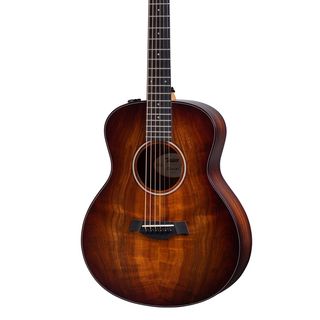
Not Taylor’s smallest offering, but definitely one of their better sounding compact instruments, the GS Mini has proven to be a hit with all manner of guitarists. You’ll even see pros use them on the biggest stages in the world.
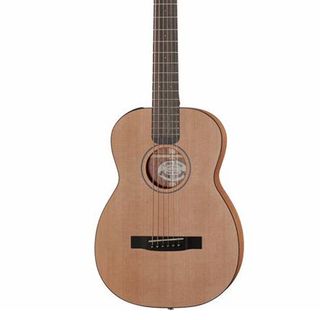
Folding guitars have been done before, but the Furch Little Jane is a folding guitar that actually sounds very, very good. This acoustic travel guitar is made from all solid woods – a solid red cedar top and solid mahogany back and sides, giving it a beautiful, mellow and warm sound.

Probably one of the most popular compact six-strings ever made, the Martin LX1E has truly earned its place on our list of the best travel guitars. It’s around a 3/4 size, with a 23” scale.
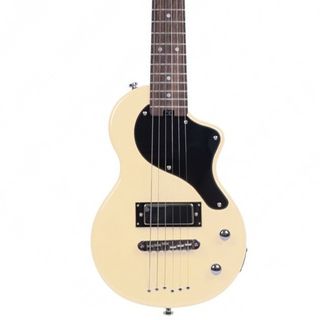
Blackstar’s Carry On range aims to provide players with quality instruments that are easy to take on planes so that you don’t have to skip your practice sessions when you’re traveling.
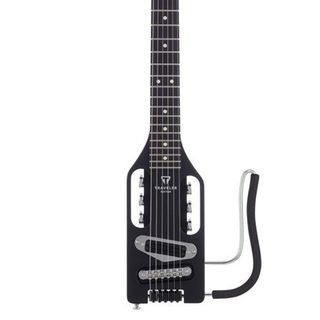
A travel guitar doesn’t necessarily always have to be short scale, and this is a case in point. The Ultra-Light Travel Guitar boasts a full 24.75” scale length, but the entire thing measures just 28”.
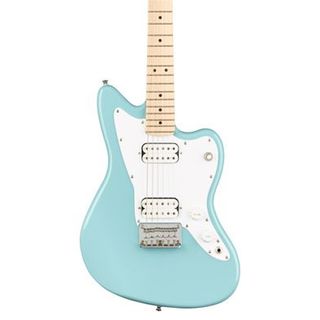
A 3/4 size guitar is smaller all over – smaller scale length (22.75” in this case), smaller body, neck, headstock etc. You might have to adjust your playing somewhat to accommodate these shrunken features, but most players can become accustomed to it.

This effectively cuts the body of a Strat down to just its scratchplate, reducing its size dramatically. The 6-in-line is then reduced to 3+3 making a further size reduction.
Best acoustic traveler
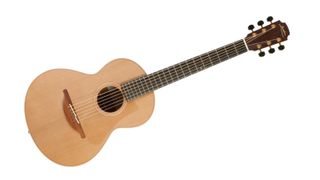
1. Lowden WL-35 Wee Lowden
Our expert review:
Specifications
Reasons to buy, reasons to avoid.
It’s incredibly bold and punchy, with superb note definition and clarity. Its dimensions are smaller than that of a more traditionally sized acoustic guitar, but the projection that it delivers would have you fooled – this guitar is loud when you push it. It also reacts beautifully to playing dynamics, offering all the shades of quiet and loud that you’d want.
Different versions of this guitar are available, but the mahogany back and sides combined with the red cedar top deliver a wonderfully balanced sound. The build quality is absolutely second to none; though of course, at this price point, you’d expect that.
Best with larger body

2. Taylor GS Mini-e Koa Plus
This GS Mini-e Koa Plus sports a solid koa top and laminate koa back and sides which allow notes and chords to ring out with complete clarity and detail. Koa responds really well to your playing – it’s responsive and dynamic so allows you to play with lots of expression. The shaded edge burst finish looks truly incredible and adds a touch of class to the whole thing too.
This 23.5” scale guitar comes fitted with Taylor’s flagship pickup system as well – the ES-2. This allows you to amplify your guitar through a PA system or amp in a way that’s more dynamic and more natural. It ships with a fantastic Aero Case that offers nearly as much protection as a hard case, but is much lighter.
Best foldable traveler

3. Furch Little Jane
Folding guitars have been done before, but the Furch Little Jane is a folding guitar that actually sounds very, very good. This acoustic travel guitar is made from all solid woods – a solid red cedar top and solid mahogany back and sides, giving it a beautiful, mellow and warm sound. It’s harmonically rich, and has some of that parlor-style punch in the midrange. It’s also extremely dynamic, projecting when you want it to, but responding nicely to softer playing.
It’s extremely well designed. The body, neck and headstock are all separate when packed down, but it’s very quick to construct when it’s time to play. The clever locking mechanism keeps the neck in place, adding the right tension to the strings, and even retaining tuning somewhat between sessions. The Furch Little Jane even comes with its own padded backpack so you can take it on your travels right away.
Best for small hands
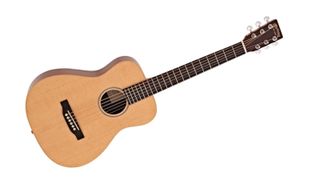
4. Martin LX1E
Probably one of the most popular compact six-strings ever made, the Martin LX1E has truly earned its place on our list of the best travel guitars. It’s around a 3/4 size, with a 23” scale. Players who are already accustomed to a full size guitar might get along with this particularly well as the neck width is about the same, measuring 1 11/16” at the nut.
Solid spruce sits atop a high pressure laminate mahogany back and sides creating a balanced but fairly bright tone. There is a touch of that boxy sort of sound you often get with smaller acoustics (though nowhere near as much as some cheaper models), and there aren’t tons of low end frequencies, but that’s if we’re being picky. Overall, the projection and tone of the LX1E is excellent.
It is available without (Martin LX1), but this is equipped with a Fishman Sonitone pickup. The controls are easily accessible and it’s very much a case of plug in and play, making it one of the best travel guitars for potentially gigging with. If you’re navigating public transport to get to shows, then this is definitely one to consider.
Best electric traveler
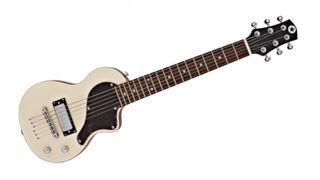
5. Blackstar Carry On Travel Guitar
Cheaper versions of this are available, but the flagship Carry On model has a number of features that make this one of the best travel guitars on the market. Made in partnership with the master luthiers at Gordon Smith, this compact instrument has a one-piece okoume body, set neck and a coil-splittable humbucker. This gives you a range of amazing tones, as well as bags of sustain.
It stays in tune well, and the intonation is just right. It’s really compact, but it plays more like a full size guitar, so you don’t lose much of the feel you’d normally get with a bigger instrument. It also comes shipped with a quality gigbag, so you’re ready to hit the road as soon as you get it.
Best with full scale length
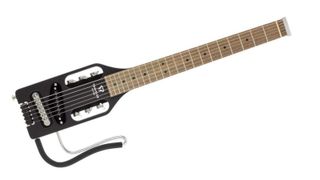
6. Traveler Guitar Electric Ultra Light
A travel guitar doesn’t necessarily always have to be short scale, and this is a case in point. The Ultra-Light Travel Guitar boasts a full 24.75” scale length, but the entire thing measures just 28”. They say that it’s actually 28% shorter and 68% lighter than your average electric guitar . The lap rest detaches when not in use too, making it extremely portable.
It’s fitted with a single dual rail humbucking pickup that delivers punchy but articulate tones. It’s not the most versatile instrument in the world, but that’s not really the aim here. Still, you can probably tackle most styles of music with it. The tuning pegs are also built into the body which obviously gets rid of the necessity for a headstock, and they actually work very well too.
If you’re flying a lot, or maybe space is at a premium in the car and you want to take this and maybe a battery powered amp with you, then this makes for a fantastic travel guitar.
Best traveling offset
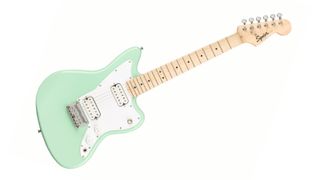
7. Squier Mini Jazzmaster
A 3/4 size guitar is smaller all over – smaller scale length (22.75” in this case), smaller body, neck, headstock etc. You might have to adjust your playing somewhat to accommodate these shrunken features, but most players can become accustomed to it. The short scale also lends the guitar a really nice slinky feel, so you might find yourself playing a little differently to normal, which can spark creativity.
This fantastic looking offset is fitted with a pair of quite high output, punchy sounding humbuckers. So, if you’re seeking a portable guitar for rocking big riffs and ripping solos, then this is absolutely one to consider.
It’s also well priced. Maybe you’re just seeking a guitar to take out occasionally, enabling you to leave your main instrument at home. This is of a good enough standard to do the job well, and it means that you’re not having to throw your more expensive guitar in the back of a car or van etc.
Best for Strat fans
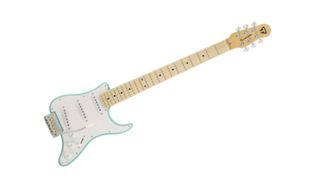
8. Traveler Travelcaster Deluxe
This effectively cuts the body of a Strat down to just its scratchplate, reducing its size dramatically. The 6-in-line is then reduced to 3+3 making a further size reduction. All in all, it’s about the size of a regular Strat, minus the headstock, making it altogether a lot more portable.
You’re not having to sacrifice anything in terms of tone here. The Travelcaster has three single-coil pickups and a five-way selector, giving you all the chimey, glassy tones that you’d expect from this kind of configuration. The tremolo works nicely too – again, something you don’t have to sacrifice.
What’s particularly great about this model is that it has the full 25.5” Strat scale length meaning that your fretting hand won’t have a clue it’s playing on a travel guitar. Chords, scales and licks will feel as they do on a full size guitar, though you might just have to slightly accommodate for a different neck profile.
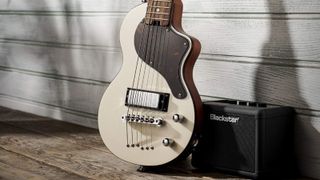
What Do We Mean By Travel Guitar?
You can trust Guitar Player. Our expert reviewers spend hours testing and comparing guitar products so you can choose the best for you. Find out more about how we test.
When we’re talking about the best travel guitars, we’re looking for instruments that are physically easier to travel with. Size and weight play a huge part, so the above choices will all be smaller than your regular full-size guitar, which in turn, will make them lighter.
Some might just have slightly reduced dimensions when compared to a full size, making it a little more practical to take out on the go. Others might have completely different designs that render them suitable for taking on planes as hand luggage. How small you want it completely depends on your wants and needs.
Electric Or Acoustic?
Of course, one of the main considerations when shopping for the best travel guitar is whether to go electric or acoustic. Acoustics, by their very nature, tend to be a little bigger with deeper bodies, but you don’t need an amp to get the most out of it. If you’re playing live, then you’ll need some amplification, but for playing on your own or with friends, you’re fine with just the guitar.
An electric travel guitar can be played without an amp, but you’ll get more from it if you plug it into something. There are some great portable amps on offer, but there’s that, plus cables, to then consider.
On acoustic travel guitars, you’ll find that some of them have a pickup fitted and some of them don’t. If you’re after a compact instrument to travel to and from shows, then having a pickup installed can be really useful. If you’re just after something to take on holiday or camping perhaps, then a pickup isn’t necessary. Buying one without a pickup will probably save you a bit of money too.
Of course, with an electric, the pickup plays a very important part in shaping your sound. You’ll find the best travel guitars are fitted with various different pickup configurations. If you’ve found a model that you like but it’s got a single coil instead of a humbucker, for example, it’s always worth checking to see if other versions are available.
Scale Length
It’s likely that a travel guitar will have a shorter scale length. Reducing this can allow the makers to produce a physically smaller guitar. It’s worth considering how that might feel for you to play, though. If you’ve got bigger hands, you might find squeezing your fingers into frets, particularly the ones higher up, more difficult. Look at the scale length, alongside the number of frets – 18 frets spaced over 23” for example, will give your fingers more space than 22 frets over the same scale.
That said, there are travel guitars that have a full length scale. They can reduce the size of the instrument in other ways, so if you know that you’re after a full scale travel guitar, then you don’t have to compromise.

At Guitar Player , our team of writers aren't just music enthusiasts; we're real-life musicians. Our hands-on experience with travel guitars ensures that our reviews and recommendations are backed by practical knowledge and real-world testing.
When it comes to selecting the best travel guitars, we leave no stone unturned. Meticulously evaluating factors like tonal versatility, sonic character, build quality, and value for money, it's only after rigorous testing in a variety of playing scenarios do we choose products for our guides. We stand by our selections, ensuring that every set of strings we recommend is one we'd use ourselves.
Read more on how we test gear and service at Guitar Player .
Get The Pick Newsletter
All the latest guitar news, interviews, lessons, reviews, deals and more, direct to your inbox!

After spending a decade in music retail, I’m now a freelance writer for Guitar Player, Guitar World, MusicRadar and Reverb, specializing in electric and acoustic guitars bass, and almost anything else you can make a tune with. When my head’s not buried in the best of modern and vintage gear, I run a small company helping musicians with songwriting, production and performance, and I play bass in an alt-rock band.
“Kudos to Jack White and Donner for creating this great-sounding and affordable piece of hardware”: Donner Triple Threat review
Best Klon clones 2024: Bringing the unattainable overdrive icon into arm’s reach
“The first rock and roll guitar god”: Instrumental guitar legend Duane Eddy has died at 86
Most Popular
- 2 “I carried Ed’s guitar picks like a little old lady carrying her purse”: Eddie Van Halen loved throwing guitar picks into the crowd – but the simple act often had unintended consequences
- 3 “Jeff was just something other, you know?”: Mark Knopfler says he had begun planning to record an album with Jeff Beck shortly before Beck's death
- 4 “Kudos to Jack White and Donner for creating this great-sounding and affordable piece of hardware”: Donner Triple Threat review
- 5 Best Klon clones 2024: Bringing the unattainable overdrive icon into arm’s reach
Guitar whammy bars: what you need to know
The tremolo (or vibrato) system is one of the electric guitar's pivotal inventions. Here's a primer on the key developments in whammy bar history
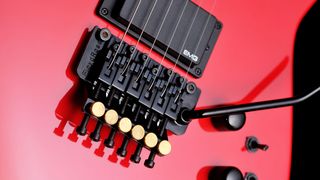
Tremolo, vibrato, vibrola, or wigglestick. They go by many names but essentially provide the same function: pitch variation of your electric guitar by altering the tension of every string at once.
This is achieved by manipulating a metal arm attached to the bridge or tailpiece. You can get some pretty insane sounds from the hardware – like dive-bombs, motorcycle revving, squeals, animal sounds, and much more – as well as more subtle dives and flutters.
There are a lot of different kinds of vibrato that have come and gone over the years. This article is focused on the mainline models, which are directly relevant today. So, here is a brief history of the whammy bar, an idea that revolutionized the guitar world.
Definitions
Let’s get some definitions out of the way. You may have heard whammy bars referred to as vibrato bars and tremolo bars interchangeably. Technically, tremolo is an oscillation of volume, and vibrato is an oscillation of the pitch itself. The terms are used synonymously, but the correct definition for the mechanism we’re talking about here is vibrato.
In some circles, “whammy” refers only to the locked kind that can take a lot of abuse and still stay in tune like the Floyd Rose. But more generally it is a blanket term to describe any kind of vibrato bar.
The history of vibrato

The first whammy bar to appear for the guitar was Doc Kauffman’s Vibrola in the late '20s and early '30s. At the time, it was not uncommon to see it featured on archtop and lap steel guitars. These early iterations were touchy and could create severe tuning issues if they were used with any amount of passion.
As legend would have it, Merle Travis – one of the most famous country guitarists in history – was tired of his Vibrola constantly forcing his guitar out of tune. He asked his friend, luthier and tech Paul Bigsby to fix it.
Get The Pick Newsletter
All the latest guitar news, interviews, lessons, reviews, deals and more, direct to your inbox!
Mr. Bigsby ran with the idea and wound up inventing the first tried-and-true guitar vibrato system, one that is still used today - the Bigsby. This new design finally created a system that was useful and brought the concept of whammy bars into the mainstream.
The term “whammy” became common slang among musicians in the 1950s. Fender would go on to perfect the early versions of whammy bars as we know them today. Companies like Floyd Rose and Kahler were not far behind.
How does it work?
These devices working a metal arm that is attached to the bridge or tailpiece of the guitar. Via this mechanism, the player is able to quickly vary the tension, and thus pitch, of the strings. This creates the pitch bend effect. While most vibrato bars can only take things down in pitch, floating designs, like the Floyd Rose, are able to raise the pitch as well by pushing the bar towards the end of the body.
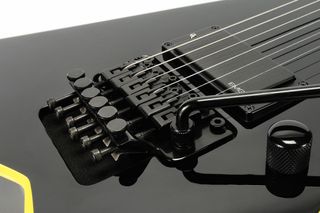
This will come as no surprise, but cheap guitars go out of tune a lot faster than guitars of high quality. It can also take some time off of string life due to them constantly being stretched. Spring tension also fades with time, leading to them needing to be replaced periodically.
Nut issues can also arise. If the nut isn’t properly cut when the strings are manipulated like this they might not return to normal pitch correctly. Getting a good tech or luthier can solve this, whether they can fix the one already on your guitar or create a new one.
The different types of whammy bars
There are two main types of whammy bars – detachable like Fender and Floyd Rose, and those that go with a tailpiece, like a Bigsby. More broadly, there are four main types – Fender floating and synchronized designs, Bigsby, and locking – like Floyd Rose and Kahler.
A lot of players overlook the differences between each type of whammy. But your playing style and what you need from it will have a massive impact on which kind is right for you
The first mechanical vibrato bridge was created and patented by Doc Kauffman in the 1930s. Originally known as the “Vibrola”, it came almost standard on the Epiphone Archtop guitars used by jazz and blues guitarists at the time. The idea was very well received. It wasn’t long before other manufacturers picked up on the interest and started incorporating them into their own designs.
A lot of players overlook the differences between each type. But your playing style and what you need from it will have a massive impact on which kind is right for you. Whammy bars come in two main types: the detachable kind like the Fender and Floyd Rose, and those that are structurally part of the bridge, like the Bigsby.
Here comes the Bigsby

The Bigsby uses a rocker bridge as its primary build point. Instead of the strings being inserted through holes in the bridge, they wrap around a metal bar that is controlled by the whammy bar. Pushing down on the arm makes the strings drop in pitch.
Before this invention, players were intrigued by the idea, but it hadn’t struck mass appeal quite yet. Today, however, Bigsby tremolos are more popular than ever. They are easy to use, have a smooth feel, and are not impossible to retrofit. It’s just as common to find them on archtop jazzboxes as it is on a Les Paul, SG, or boutique models.
Sure, Bigsbys can’t get as extreme as certain other systems. But they are smooth, subdued, and subtle. And for a lot of players that is perfect. Their throwback look and unique sound have helped to keep them popular with players to the present day.
Finally, Fender
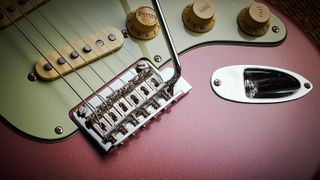
As in many areas, Fender was a true trailblazer in the world of whammy bars. The synchronized vibrato was released with the Stratocaster in 1954. Its name originates from its design, which allowed the saddle and strings to move in unison. This helps to eliminate saddle friction so that the strings return to their starting pitch when the bar returns to its normal position.
The first iteration of Fender’s tremolo was floating, but the company settled on the synch design as it provided more tuning stability. Upon release, it was more stable and capable of more extreme pitch bends when compared with the Bigsby, which piqued the interest of guitarists.
Like most Fender innovations, it is one of the most significant in the history of guitar.
Fender floating tremolo
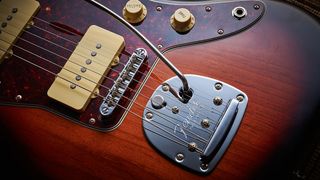
Fender patented the concept of the floating tremolo in 1958. This radical idea allowed the strings to be lowered and raised in pitch, and did so without much effort from the player.
The floating tremolo slightly raises off of the guitar body, but provides lower action. When the Jazzmaster was released to the world it had this style of vibrato, and vintage Jaguars and Mustangs are also equipped with a similar mechanism.
It wasn’t without its faults, however. Fender's floating trem was known to go out of tune easily and could be a little finnicky. However, if you’re the type of player who wants a sweeter, more natural sound, the Fender floating might be just what you’re looking for.
Floyd Rose takes it to the next level
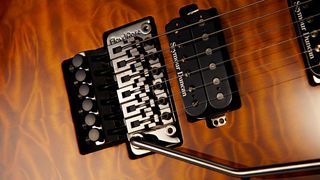
Floyd D. Rose created the first locking tremolo in 1979. The late, great Eddie Van Halen certainly helped to popularize it, and to this day, it remains still a gold standard for players who want more extreme effects like dive-bombing. This is because it offers a very wide range of pitch change.
It took influence from the Fender synchronized model, but in a Floyd Rose, the strings remain locked in place to prevent tuning and intonation issues. You just tune your guitar to pitch, then lock down the nut and bridge with an Allen wrench. Since the system is “floating”, pitch can be raised or lowered. This makes it more stable for these types of maneuvers.
Floyd Rose designs offer lower action than other systems, perfect for shredding and fast playing. The only real downside to this type is that they can fly out of tune if a string breaks, due to the way the system is balanced. This type of system also requires a specific body route and can be difficult to retrofit.
The downside is that Floyd Roses are somewhat difficult to set up and require a special (but easily accessible) set of tools that aren’t required for other models. Changing string gauge can drastically affect how it performs, too.
Thank you for reading 5 articles this month**
Join now for unlimited access
US pricing $3.99 per month or $39.00 per year
UK pricing £2.99 per month or £29.00 per year
Europe pricing €3.49 per month or €34.00 per year
*Read 5 free articles per month without a subscription
Prices from £2.99/$3.99/€3.49
“I swear that guitar plays itself… Who’d have thought a 16-year-old girl like me could suddenly have this crazy connection with Jerry Garcia?” Meet Bella Rayne, the guitarist who jumped from Mom’s Strat to wielding Garcia’s ’Gator onstage
Everything you need to know about fretwraps: what are they and do you need one?
“Ronnie gave me great advice about building a guitar solo... left to my own devices, it would have been a case of how many notes I could fit in!”: Vivian Campbell looks back on the 1984 Dio classic The Last In Line
Most Popular

Travelcaster Deluxe Review
by Chris Devine | Jul 24, 2018 | Best Electric Guitars
Performer takes a hands-on look at the Travelcaster Deluxe from Traveler Guitar. Do good things really come in small packages? Read on for more…
Traveling with an instrument is difficult at best, even when it’s in a lightweight gig bag. There are travel-sized instruments, but with limited features sound wise and shorter scale lengths, which means it doesn’t feel and sound like a “real” instrument. Traveler Guitar figured out how to get a full-size instrument with a full-sized sound into a more travel friendly situation.
The body is not much bigger than a standard sized S-style pickguard. The Surf Green finish of our test model more or less comes in as a colored accent from the front view. Flipping it over there are some familiar hardware bits, such as a standard S-style input jack and strap buttons. The neck joint has a beveled edge, allowing for easy upper fret access. It’s very interesting to note that the tremolo block hangs out the back of the body, exposed. One might think, is this going to affect any playability? But amazingly it doesn’t. It feels like a normal 2-point S-Type bridge, with a pop in tremolo arm that can be adjusted for the tightness of its “swing.”
The maple neck and fingerboard feel very nice, and are fitted with medium jumbo frets, which feels very familiar, however it’s a 3+3 tuner configuration on the headstock which brings the standard 25 ½” scale under a 34” overall length. Electronics-wise it’s quite familiar, with three ceramic magnet single coil pickups, a master volume, neck tone, middle tone, and a 5-way switch.
Picking it up it feels odd, and yet strangely familiar. Without all that extra body mass, it’s easy to get the hand into a very comfortable picking position. With the pop-in tremolo arm, the trem feels, well normal. Strapping it on, it’s nicely balanced, and in a seated position, it sits nicely where a normal guitar would go. The pickups are quite robust in all configurations, with more than enough output. Clean, Tele-style chicken pickin’ tones in positions 2 and 4 have enough warmth and quack, just like you would expect, and each pickup individually doesn’t disappoint. With a bit of grit from an overdriven amp, it delivers big (and almost unexpected) tones. Getting into more heavy drive, the usual single coil 60 cycle hum is there, but that’s no surprise. Comparing it to a full-size S-style guitar, it’s certainly not lacking tone or beefiness in any way.
Our test guitar was strung up with .09 strings, so it felt like a slinky S-type. The frets were well polished and finished, and the bone nut is a really nice touch. With this uniquely “less is more” body, and great feeling neck, it is a joy to play overall, and doesn’t feel or sound like it’s missing anything. Not what we expected at all.
Overall, for a player who does a lot of traveling this is well worth it. In its gig bag it can easily fit in the overhead compartment of an airplane with no fuss. Heck, a touring artist that might want to bring an additional electric on the road but shies away because of space issues should seriously consider one (or two) of these. There’s really no downside to one of these; they deliver a full-sized guitar in a travel sized package. Consider us impressed.
Great neck, excellent fretwork, familiar feel, great single coil tones.
Aesthetics might not appeal to everyone.
STREET PRICE:
$299 [click to buy now]
Best travel guitars: Top acoustic and electric guitars for musicians on the go
Out top picks for practicing your guitar on the move, wherever the road takes you
Best for tone
Best for volume, best for value.
- Best Strat-alike
- Best electric
- Best full-scale
- #1 acoustic-electric
Best for portability
- Best solid wood
- Buying advice
- How we choose
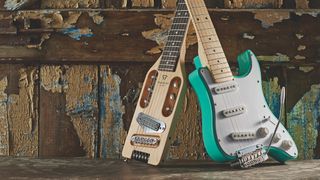
1. The quick list 2. Best for tone 3. Best for volume 4. Best for value 5. Best for Strat players 6. Best electric travel guitar 7. Best full-scale travel guitar 8. Best acoustic-electric model 9. Best for portability 10. Best solid-wood travel guitar 11. Buying advice 12. How we choose products
As guitar players, our passion and joy shouldn’t have to stop the second we leave the house or the practice room. Sometimes, when you’re on the go; whether that be travelling for work or just for fun, you want to be able to take your music with you. That’s where the best travel guitars come in.
Travel guitars are smaller, more compact instruments that are easier to take on the road. If you’re heading out on a road trip, and space in the car is tight, a travel guitar will fit in a much smaller gap than a full-size guitar. Some of them even pack down into a rucksack so you can take them on a plane as hand luggage.
It doesn’t matter whether you’re more into playing acoustic or electric, we’ve picked out the best travel guitars currently on offer to make sure that the music doesn’t have to stop when you hit the road.

Chris Corfield is a journalist with over 12 years of experience writing for some of the music world's biggest brands including Orange Amplification, MusicRadar, Guitar World and Dawsons Music. Chris has spent years writing about and testing guitar gear for MusicRadar, in addition to nerding out about everything from synths to microphones, DJ gear and music production hardware.
Best travel guitars: Quick list
Want to cut to the chase and find out exactly which we think are the best travel guitars on the market right now? Below, you’ll find a round-up of our top choices. You can jump to a more detailed review of every pick, along with our price comparison tool to help you find the best deals.
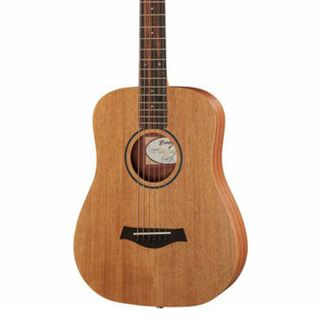
This ¾-sized dreadnought comes with all the quality and projection you’d expect from one of the acoustic world’s biggest names, just in a size that can be hauled around anywhere without breaking your back. Or, indeed, your wallet.
Read more below

The Martin Backpacker has a unique body shape, that’s for sure, but coming from a name like Martin you can rest assured this guitar will perform brilliantly. What surprised us was the volume and projection this little guitar pumps out, thanks in part to the solid mahogany used in the body.

The Steinberger Spirit GT-Pro Deluxe definitely fits the travel guitar bill due to its distinctive size and shape. Despite the smaller body, the Spirit GT-Pro Deluxe features a scale length of 25.5”, making the actual playing area larger than that of a standard Les Paul.
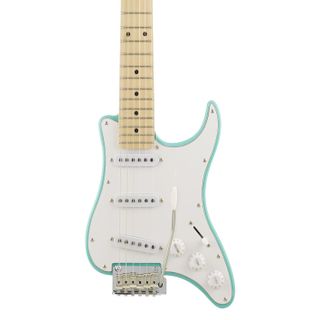
You can instantly see those famous Stratocaster outlines of the pickguard, the three single coil pickups and the control knobs. Yet the eagle-eyed among you will have noticed anything on the body that isn’t underneath the pickguard has been shaved away, leaving a guitar which is 35% lighter and 14% shorter than a regular Strat.
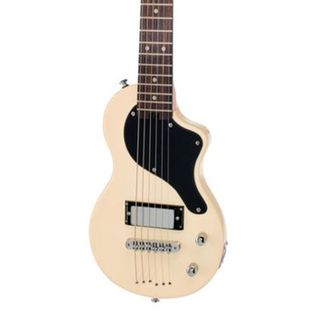
This is a short-scale travel electric guitar featuring a single mini-humbucker, two-piece poplar body, bolt-on neck and fairly sturdy tuners. It doesn’t pack down any smaller than it is, though it’s very compact already and if you really needed to, you could always take the neck off, if you were packing it up in a suitcase for example.

The Shorty provides full scale-length familiarity which, when combined with the tiny body, makes for a comfortable playing experience. The single humbucker at the bridge is meaty enough to blast out your favourite riffs, while you’ll feel instantly at home with the classic maple/rosewood combination neck and fingerboard.
Load the next 3 products... ↓
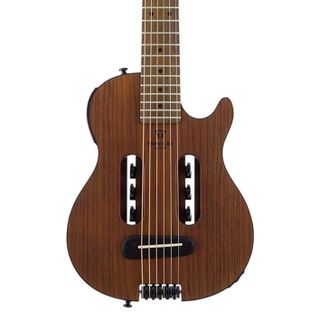
The Traveler Escape Mark III comes equipped with plenty in the way of tools and toys, and it all comes in 26% shorter and 10% lighter than a standard dreadnought. The Escape Mark III features tuning pegs within the body itself, which means it has no need for a headstock and is instead strung in reverse.
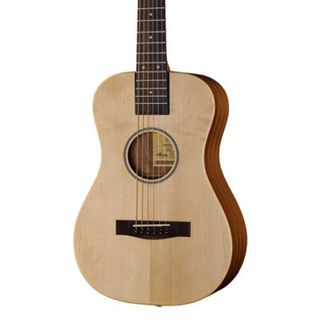
This handy, foldable acoustic is great for players who want something quality but affordable. It’s got a solid spruce top and layered mahogany back and sides. You can get a great tone from it, whether you’re playing with a pick or with fingers. It’s dynamic, and while it might not be as loud as a full size guitar, can still throw out a good amount of volume.

This is one for serious acoustic players. It bears a hefty price tag, but you can get some serious tones from this guitar. Boasting a solid red cedar top and solid African mahogany back and sides, the Furch Little Jane yields a beautiful, rich and balanced tone with a good amount of projection.
The best travel guitars right now
MusicRadar's got your back Our team of expert musicians and producers spends hours testing products to help you choose the best music-making gear for you. Find out more about how we test.
Below you'll find full and detailed write-ups for each of the best travel guitars in our list.
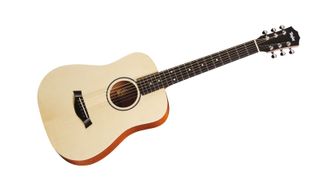
1. Taylor Baby Taylor
Our expert review:
Specifications
Reasons to buy, reasons to avoid.
If the more outlandish styles of travel guitar aren’t for you, maybe the Baby Taylor will be. This ¾-sized dreadnought comes with all the quality and projection you’d expect from one of the acoustic world’s biggest names, just in a size that can be hauled around anywhere without breaking your back. Or, indeed, your wallet.
The Baby Taylor would be the perfect option as a second (or third) guitar in anyone’s collection, designed to be stashed in the included gig bag and taken anywhere. Players with larger hands may feel a bit cramped navigating the 22.75” scale length, but for the majority of people the Baby Taylor is easy to recommend.
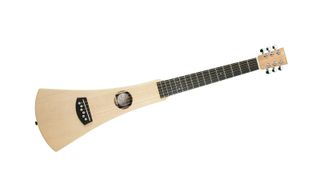
2. Martin Backpacker
We weren’t lying when we said travel guitars can jar a bit visually. The Martin Backpacker has a unique body shape, that’s for sure, but coming from a name like Martin you can rest assured this guitar will perform brilliantly. What surprised us was the volume and projection this little guitar pumps out, thanks in part to the solid mahogany used in the body.
Originally launched in 1992, the Martin Backpacker has carved itself a nice niche in the world of travel guitars, and its exceptional build quality means it will last for many more years to come.
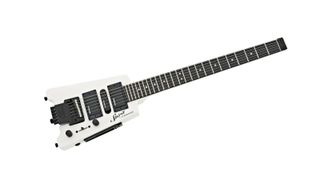
3. Steinberger Spirit GT-Pro Deluxe
While not officially marketed as a travel guitar, the Steinberger Spirit GT-Pro Deluxe definitely fits the bill due to its distinctive size and shape. The classic Steinberger ‘headless’ design is correct and present, making the same bold visual statement of its more expensive stablemates, yet the decision to use wood over composite materials makes the whole thing more cost-effective and suited for travelling.
Despite the smaller body, the Spirit GT-Pro Deluxe features a scale length of 25.5”, making the actual playing area larger than that of a standard Les Paul. It’s also pretty rare to find neck-thru bodies at this price point, which all adds up to a decent value instrument regardless of how you end up using it.
Best for Strat players

4. Traveler Travelcaster Deluxe
It’s called ‘cognitive dissonance’. That conflict you feel when something you know to be right is challenged. The Traveler Travelcaster Deluxe is a relative example; to look at it, you can instantly see those famous Stratocaster outlines of the pickguard, the three single coil pickups and the control knobs. Yet the eagle-eyed among you will have noticed anything on the body that isn’t underneath the pickguard has been shaved away, leaving a guitar which is 35% lighter and 14% shorter than a regular Strat.
Weighing in at only 5 lbs, the Travelcaster Deluxe may take some getting over visually, but in use it provides that same Strat experience, the same 25.5” scale length and the same tonal versatility of those pickups. If you can get over the cognitive dissonance, it may just be the perfect travel guitar for you.
Read the full Traveler Travelcaster Deluxe review
Best electric options
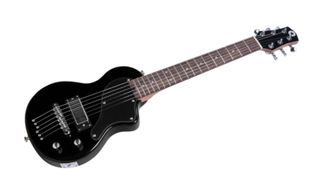
5. Blackstar Carry-On Travel Guitar ST
This is a short-scale travel electric guitar featuring a single mini-humbucker, two-piece poplar body, bolt-on neck and fairly sturdy tuners. It doesn’t pack down any smaller than it is, though it’s very compact already and if you really needed to, you could always take the neck off, if you were packing it up in a suitcase for example.
It plays great and the shorter 20.7” scale length doesn’t take long to readjust to - younger beginners might find that they can fret chords and make stretches between frets more easily too. The mini-humbucker covers a lot of ground, so will suit any musical style you can throw at it. Whether you’re playing clean or super distorted, this little thing can really pack a punch!
There is a more expensive version that’s around double the price with some upgrades, but in terms of value for money, we feel that the Blackstar Carry-On ST is one of the best travel guitars around.
Best full-scale experience

6. Hofner Shorty travel guitar
The Hofner Shorty has been around since the 1980s, and has long been a favourite for players looking for a portable electric they can travel with. It provides full scale-length familiarity which, when combined with the tiny body, makes for a comfortable playing experience. The single humbucker at the bridge is meaty enough to blast out your favourite riffs, while you’ll feel instantly at home with the classic maple/rosewood combination neck and fingerboard.
Sure, it’s not going to win any awards for tone, and you’re unlikely to see them used on album-of-the-year contenders, but as an inexpensive way to add a bit of portability to your line-up the Hofner Shorty is well worth consideration.
Best of both worlds


7. Traveler Escape MKIII Mahogany
Choosing a travel guitar doesn’t necessarily mean compromising on your needs. The Traveler Escape Mark III comes equipped with plenty in the way of tools and toys, and it all comes in 26% shorter and 10% lighter than a standard dreadnought.
The Escape Mark III features tuning pegs within the body itself, which means it has no need for a headstock and is instead strung in reverse. The onboard electronics are both extensive and useful too, with an under-saddle Shadow NanoFlex piezo system, tuner, aux-in and studio headphone out making for quite a comprehensive setup for the traveling player.
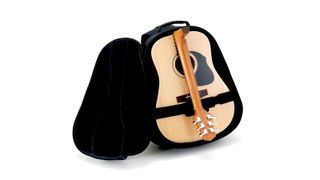
8. Journey Instruments PJ410N
This handy, foldable acoustic makes for one of the best travel guitars for players who want something quality but affordable. It’s got a solid spruce top and layered mahogany back and sides. You can get a great tone from it, whether you’re playing with a pick or with fingers. It’s dynamic, and while it might not be as loud as a full size guitar, can still throw out a good amount of volume.
It fits perfectly inside the included padded rucksack, and can be assembled in 20 seconds. Simply put the neck into position, snap it in place and lock it from the back of the body. Then you’ve got a guitar with a 23” scale ready to play. It’s great for experienced players who want something that sounds good while they’re on their travels (the bag will fit under many airline seats), but also makes for a great beginner guitar for kids .
Best all-solid option
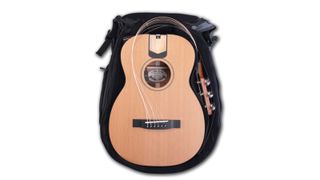
9. Furch Little Jane LJ-10
This is definitely one of the best travel guitars for serious acoustic players. It bears a hefty price tag, but you can get some serious tones from this guitar. Boasting a solid red cedar top and solid African mahogany back and sides, the Furch Little Jane yields a beautiful, rich and balanced tone with a good amount of projection.
The guitar can be folded down and fit into a rucksack (included). The headstock, neck and body are separate from one another to save space but can be assembled into one piece very quickly and easily. Once the neck is locked into position using Furch’s proprietary assembly system, it’s ready to play and will even go back in tune.
The included rucksack is well padded and will ensure that it’s protected enough on your travels. Travel acoustic guitars seldom sound this good, and to be fair the price reflects that, but it really is one of the best out there.
Best travel guitars: Buying advice
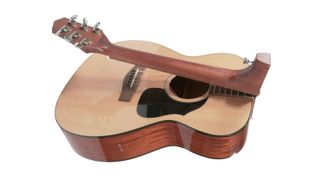
What is a travel guitar?
Essentially, a travel guitar is a guitar designed with portability and mobility as its key function. This will usually mean the guitar has a significantly smaller body or weight, and they often boast creative solutions to common issues like tuning or storage. From conception to construction, the travel guitar is designed to be thrown in a bag and transported anywhere, everywhere, and all those places in between.
Standard-sized guitars can be, as we know, too large, too heavy or too delicate to carry around for long stretches, so travel guitars offer a specialist tool for those specific situations. Realistically, you’ll not find too many studio musicians reaching for the travel guitar to nail that perfect tone, but then that’s not what they’re for. Portability, size and weight are order of the day here, and it helps that there are travel guitars on the market today which also nail that other crucial element; tone.
What makes travel guitars different?
At first glance, the sight of a dedicated travel guitar can jar a little. Often, they have quite striking aesthetic differences from regular guitars. Like looking at something you know, only quite different. Manufacturers employ all kinds of measures as they seek to reduce the overall size and weight of the guitar, and it’s not uncommon to see guitars without headstocks, or with radically different shaped bodies, or even no body at all. Yet a guitar still has to function, so there is still the need for tuning pegs, a bridge, and other essential components.
What are the key features of travel guitars?
There are two major schools of thought when it comes to travel guitars. One is to take a regular sized guitar and zap it with a shrink ray, keeping the same proportions relatively but in a smaller overall package. This approach ensures the instrument retains its familiarity, and also makes them attractive to younger learners.
The other approach is to redesign the instrument completely, perhaps taking the tuning pegs and installing them in the body. Of course, such radical design changes can create other problems, so you may see these compensated for with the inclusion of detachable arm and leg rests, for example. While these guitars may look unfamiliar, the playing experience should be largely the same as a regular guitar. Scale lengths, fret locations and pitch will be the same, even if the physical form of the guitar is quite different.
Are travel guitars playable?
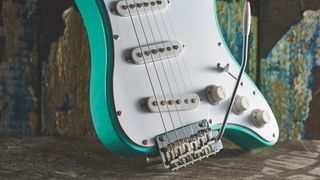
If you’ve never had the chance to play a travel guitar, you may be looking at the best travel guitars in this list and wondering if it’s playable in the same way as a regular guitar. The good news is that yes, absolutely they are playable. In the same way that jumping from the thin neck of an Ibanez RG-style electric to a 50’s style Stratocaster neck may take a bit of readjustment in your technique, so too will the leap from a regular to certain travel-sized guitars. It’s not difficult to adjust though. You may also have to sit differently to accommodate the smaller body, but as these guitars are inherently lighter in weight, this shouldn’t cause too much of a headache. Or, more accurately, backache.
Electric or acoustic?
All of the best travel guitars will either be electric or acoustic. Electrics do tend to be thinner, as the body doesn’t need to resonate as much to get a good sound, although it’s worth remembering that you’ll need an amp to get the most out of it. The body of a travel acoustic will normally be deeper, but as a result of this you can get a fairly loud sound without any amplification.
What do I get when I spend more?
The quality of the best travel guitars does vary, and as you might imagine, it does go up as you spend more money. As the price increases, you’ll likely find better hardware, which can not only help keep the guitar in tune and playing nicely, but can also improve how it sounds too, increasing resonance and sustain.
On electrics, you’ll find better quality pickups - these will be more dynamic and have a wider frequency range so you’ll get more detail and clarity. With travel acoustic guitars, you’ll get better quality, and even solid woods which will give you a better, more responsive and richer sound.
Who might use a travel guitar?
The breadth of today’s range of travel guitars means there is a guitar to suit most playing styles and genres, so the quick answer is that yes, there is a travel guitar for everyone. In terms of scenarios, travel guitars are, as their name suggests, designed to be taken places ordinary guitars cannot reach.
Small enough to fit on your back as you scale a mountain, or taken on a plane as part of your hand luggage, travel guitars give players the freedom and convenience of being able to play anywhere, at any time. For that, we applaud them. Let’s examine some of the best travel guitar options available today.
Can you buy travel guitars for children?
Travel guitars, as well as being the perfect accompaniment to a musician on the go, can also make for great instruments for children. If you’re looking for one of the best travel guitars to get a kid started on their guitar playing journey, then look for one that has a shorter scale length. This will mean that the notes are closer together and will be easier for small hands to fret.
Scale length and string gauge
Speaking of short scales, the gauge of strings you use is also worth considering. The strings on a guitar with a shorter scale will feel slinkier - they will be easier to bend and to some players may even feel too loose. One way to combat this is to use thicker strings, so something like 12s on an electric might make them feel a little more like 10s on a full size guitar. Though, if you’re just starting out then the thinner, slinkier strings might be better so they don’t quite hurt your fingertips as much.
How we chose the best travel guitars for this guide
Here at MusicRadar, we are experts in our field, with many years of playing, creating and product testing between us. We live and breathe everything music gear related, and we draw on this knowledge and experience of using products in live, recording and rehearsal scenarios when selecting the products for our guides.
When choosing what we believe to be the best travel guitars available right now, we combine our hands-on experience, user reviews and testimonies and engage in lengthy discussions with our editorial colleagues to reach a consensus about the top products in any given category.
First and foremost, we are musicians, and we want other players to find the right product for them. So we take into careful consideration everything from budget to feature set, ease of use and durability to come up with a list of what we can safely say are the best travel guitars on the market right now.
Find out more about how we test music gear and services at MusicRadar.
Related buyer's guides
- The best acoustic guitar strings to get the most from your guitar
- ...and the best electric guitar strings
- Sharpen your chops with the best practice amps
- Keep your guitar safe on the road with the best guitar cases and gig bags
- Want something even smaller? These are the best ukuleles
- Need some inspiration? Check out these gifts for guitar players
Get the MusicRadar Newsletter
Want all the hottest music and gear news, reviews, deals, features and more, direct to your inbox? Sign up here.

Chris Corfield is a journalist with over 12 years of experience writing for some of the music world's biggest brands including Orange Amplification, MusicRadar, Guitar World, Total Guitar and Dawsons Music. Chris loves getting nerdy about everything from guitar and bass gear, to synths, microphones, DJ gear and music production hardware.
“The absolute best ambiences we’ve ever made”: Run two reverbs at once with Strymon’s feature-packed BigSky MX
“A luxurious and refined take on a classic circuit”: KittycasterFX reimagines the Muff with the Mohair Fuzzstortion, pairing fuzz with a treble booster circuit for super-versatile performance
“A magnificent synth and worth the large outlay if you make the most of the year's All Access content”: Minimal Audio Current review
Most Popular

Home » Guitars » 17 Best Headless Guitars in 2024 (All Price Ranges)
17 Best Headless Guitars in 2024 (All Price Ranges)

Headless guitars are back and more popular than ever! It’s pretty incredible to see their spike in popularity over three decades after being first conceptualized and built by American creator Ned Steinberger in the 1980s.
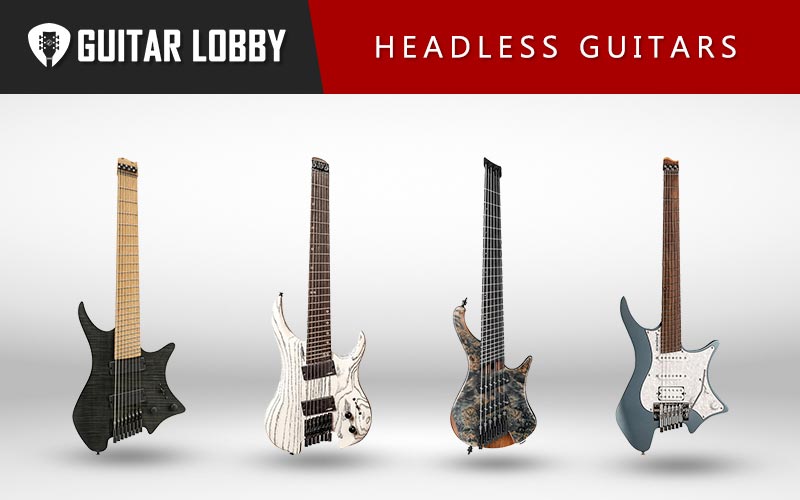
It’s fair to say Mr. Steinberger was ahead of his time as a new generation of guitarists, who tend to embrace modernity in guitar design, have paved the way for newer shops such as Kiesel and Legator who now produce their own renditions of the headless guitar concept.
I’ll start this article by sharing my thoughts on some of the best headless guitars out there right now, but if you want to learn more about them before reading reviews, check out our headless guitar information guide at the bottom of the page here .
Here Are the Best Headless Guitars
1. ibanez qx (best value).
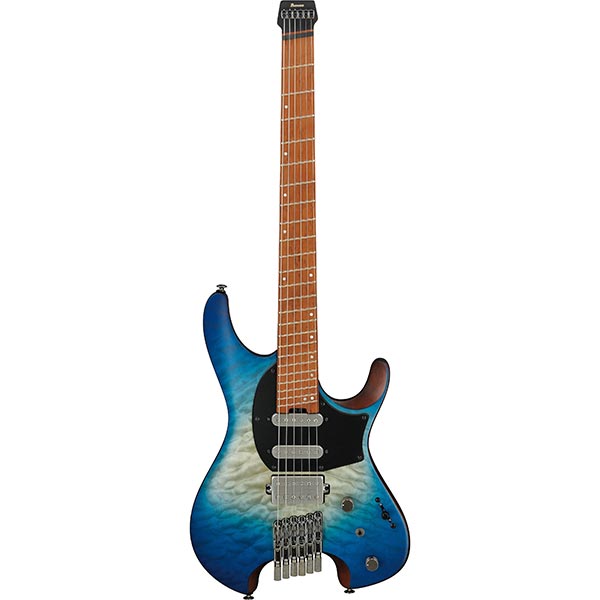
Shop on Sweetwater
Shop Guitar Center
Estimated Price: $1,100
Pickup Configuration: R1 (S) neck, R1 (S) middle, Q58 (H) bridge Bridge: Ibanez Mono Tune Bridge Scale Length: 25.5” Body Material: Maple top / Nyatoh body Neck: 3 piece Roasted Maple/Bubinga Fret Count: 24 Fretboard Radius: 508mm Country of Origin: Japan
My Review: The Ibanez Q (Quest) series includes both slanted frets (QX) and traditional straight fret (Q) models. I’m personally not as experienced with slanted frets in my own playing, but when I sat down with each model for this review I forced myself to handle the fanned fret version as much as possible. I expected there to be more of a learning curve, but that didn’t end up being the case. My hand settled in on the slant of the frets quite naturally. One thing I learned is that this is especially natural for the hand in a more modern seated playing position with the guitar propped up high on your leg. I’m sure this was by design. The specific 8 degree slant of the frets is no accident and seems to be yet another great example of Ibanez listening and working with musicians on what they want out of a modern day guitar.
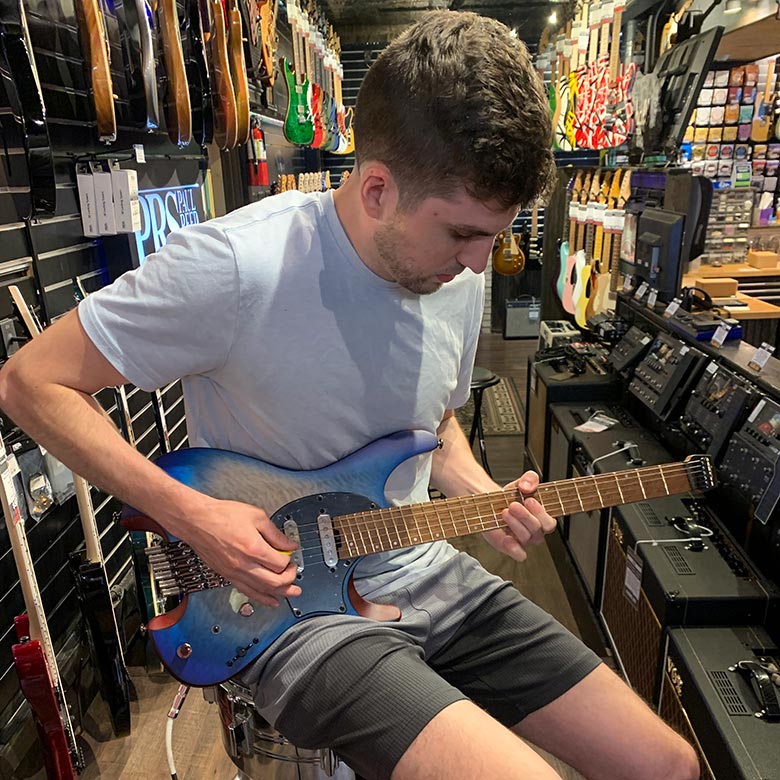
I loved the feel of the neck on this guitar. Even though the guitars i played were brand new, the roasted maple with satin finish neck had a perfectly “broken in” feel that so many guitar players desire. That, along with the narrow fanned frets made for a very natural playing experience, especially for fast tapping action.
I couldn’t believe how incredibly light this guitar felt. I put the guitar on a scale and this one in particular weighed in about 5.8 lbs. What I thought made this guitar feel even lighter then what it was is the compactness. Being someone used to holding a guitar with a headstock, you may be used to the weight of the guitar being more spread out. Picking up a headless guitar has a much more stable feeling with no subtle deadstock to body weight teetering.
The hardware is all good quality. The pots and tuning bridge move smoothly and are consistent. This guitar has a 5 way selector switch which function like a typical HSS Strat system would, however there is also an Alter switch, which when ON engages 5 additional pickup configurations. I love when guitars electronics offer as much versatility as possible so this was a huge plus for me. I spent the first hour just going through the switching system to dial in different tones. The one master volume and master tone simplified things a bit in that regard. I would have preferred a second tone knob to be able to blend atleast a subset of the pickup combinations but this configuration is fairly standard for headless guitars so its not necessarily a shortcoming compared to other comparable models.
I was disappointed these guitars only came with a gig bag. I personally prefer a hardshell case, especially for transportation purposes. I would describe the gig bag quality as “decent”. It has some padding, made out of a durable feeling material, has 2 front pockets to keep your cables and other accessories, and has both a hand grip and backpack straps for your preference in carrying method. Its also branded “Ibanez” if you like to show off your brand loyalty.
Headless guitars have historically been more of a niche product in the guitar market since their conception. Unless you live in a major city with music stores that stock boutique products, it’s can be difficult to even find headless guitars in your local music shop. This makes it next to impossible to try before you buy. Sometimes Guitar Center may have 1 or 2 Strandberg type guitars in store, but selection is typically very limited. One of the reasons I’m so excited about the Ibanez Q series is it will give alot more buyers a chance to walk into a local guitar store, pick up a headless guitar and play it for the first time. On top of that, this is made by one of the best known and trusted brands and is priced relatively affordably.
Target Customer: Modern and Prog metal, pop, rock players. Modern Finger tapping style.
Bottom Line: High build quality and all the specs that you expect from a fully equipped modern guitar all at an affordable value.
2. EART Headless Electric Guitar (Budget Pick)
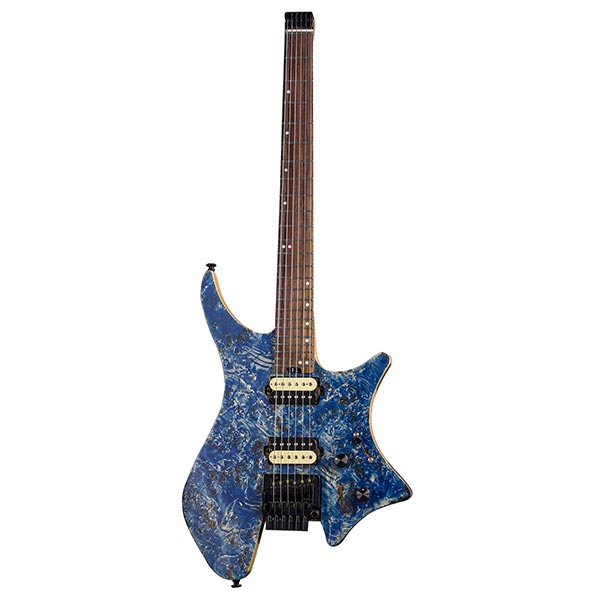
Check Amazon Price
Estimated Price: $300
Pickup Configuration: 2 open double coil humbuckers Bridge: W1 model with Tremolo, W2 model with fixed Bridge Body Material: Carbonized African redwood xylophone body Neck: Maple, “C” curved Frets: Highly durable stainless steel frets Fretboard: Indian rosewood
My Review: Let me just say that I really enjoyed playing this one. I would honestly describe the fret job as “really good”, considering the price point. The playability was great and right out of the box, the guitar just needed a quick tune. The intonation was really close as was the action. Only some minor tweaking was needed to set up. The neck felt great and I was very impressed with the finish. The veneer they use on these guitars simply looks awesome.
Hardware is decent, but I suppose that’s where you can say they cut costs on this one for affordability. It’s safe to say they focused on quality in all the places it matters most and cut corners where it matters least. The neck, body, and fret job quality is good for the price, but I would rate the electronics as “usable” and suggest this is something that could be upgraded later. But electronics is a project that is easy enough for most tinkerers and would make a significant and budget friendly improvement.
I can tell you you’ll likely be very happy with this purchase. This is easily one of the best values on the market.
Key Specs and Features: There are 2 bridge options available, the W1 version will have a Tremolo bridge whereas the W2 version will have a fixed bridge setup. There are several incredible looking veneer finishes to choose from
Target Customer: Modern progressive metal, metal, rock, electro, modern pop-rock, and even jazz
Bottom Line: This headless guitar easily forced its way toward the top of this list with its great looks, awesome playability, and absolutely unbeatable value. When comparing it to a Strandberg guitar like it is styled after, I like to describe this guitar as 80 percent of the guitar for 20 percent of the money.
3. Strandberg Boden Fusion 6 (Best Overall)
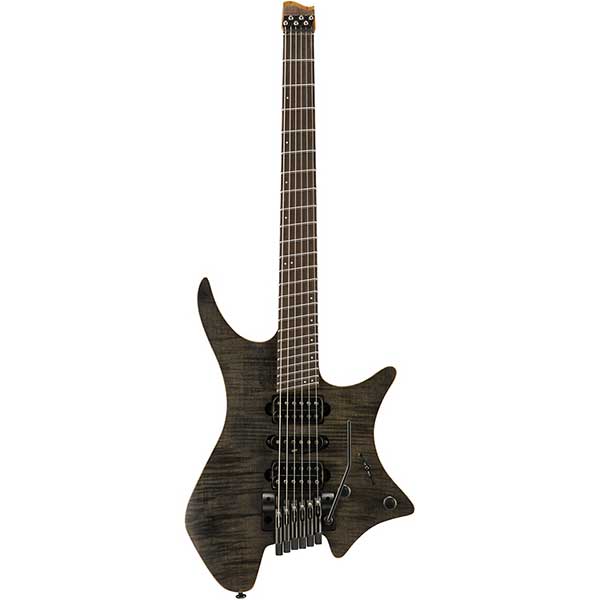
Estimated Price: $2495
Pickup Configuration: 2 humbucking pickups and 1 single-coil pick Bridge: Strandberg EGS 5 Tremolo Scale Length: 25″–25.5″ multi-scale fingerboard Body Material: Alder Solidbody, Chambered Neck: Roasted Maple EndurNeck Fretboard Radius: 20″-radius fretboard with jumbo frets Fret Count: 24 Country of Origin: Indonesia
My Review: I absolutely love the chambered body on this guitar and the overall feel, when playing. Compared to the classic model, the pickups on fusion are slightly better. As the name entails, it’s perfect for fusion, and, while slightly on the pricey side, it definitely makes up for it. Interestingly, the neck of the guitar is thinner around the higher notes, making it easier to solo around that range. Of course, I’m in love with the EndurNeck, the intonation on this guitar is excellent and the tremolo system is stable and I like how much expression can be added by subtly using it.
Key Specs and Features: Another Strandberg beauty, this Fusion 6 features an Alder Solidbody, Chambered body, with a Roasted Maple EndurNeck. The pickup configuration is 2 humbucking pickups and 1 single-coil pick, with a .strandberg EGS 5 Tremolo Bridge. It has 24 jumbo frets with a 20” radius and a 25″–25.5″ multi-scale fingerboard.
Target Customer: If you’re looking for a great fusion headless guitar, then this guitar is for you.
Bottom Line: This instrument is extremely versatile, easy to play, and full of quality. If you can afford to invest more in your purchase and upgrade from the Classic version, then getting Fusion is definitely a good decision.
4. Strandberg Boden Plini Edition Natural (Best Signature)
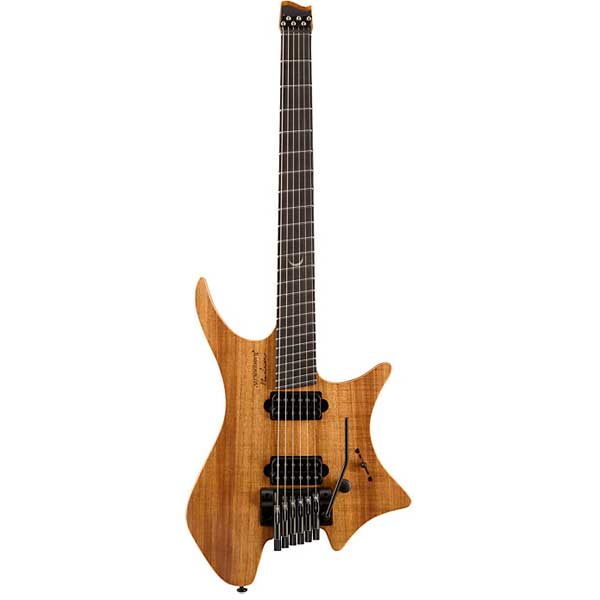
Pickup Configuration: Suhr SSH+ and SSV pickups with a 3-way switch Bridge: Strandberg EGS Series 5 tremolo bridge & string locks Scale Length: Long Scale: 25.5” and Short Scale: 25” Body Material: Chambered Swamp Ash body with a maple top Neck: Roasted Maple neck Fret Count: 24 frets Fretboard Radius: 20’’ Country of Origin: Indonesia
My Review: If you’re into the modern progressive metal guitar scene, you’ve probably heard of Plini! Well, just like his music, this signature guitar is full of beauty and variety. Due to its advanced pick-up configuration, as well as the superior wood build, this guitar is well suited for premium quality sounds in any genre, whether you’d like to play hardcore djent riffs or just really intimate jazzy harmonies.
Key Specs and Features: The Strandberg Boden Plini Edition Natural features a superb Chambered Swamp Ash body with a maple top and a Roasted Maple neck. There are a total of 24 frets, with a fretboard radius of 20’’. Built-in Indonesia, this beautiful guitar has a Strandberg EGS Series 5 tremolo bridge & string locks and a pickup configuration of Suhr SSH+ and SSV pickups with a 3-way switch. The Long Scale is 25.5” and the Short Scale is 25”.
Target Customer: If you love Plini, an electric guitar with great acoustic and futuristic looks, then this guitar is for you.
Bottom Line: I really like Plini’s take on improving the stock Strandberg Guitar versions and feel like this guitar has its own character, capable of beautifully covering any styles from jazz to progressive metal and really taking that Solo Guitar journey further.
5. Asmuse Headless Travel Guitar (Best Travel Size)
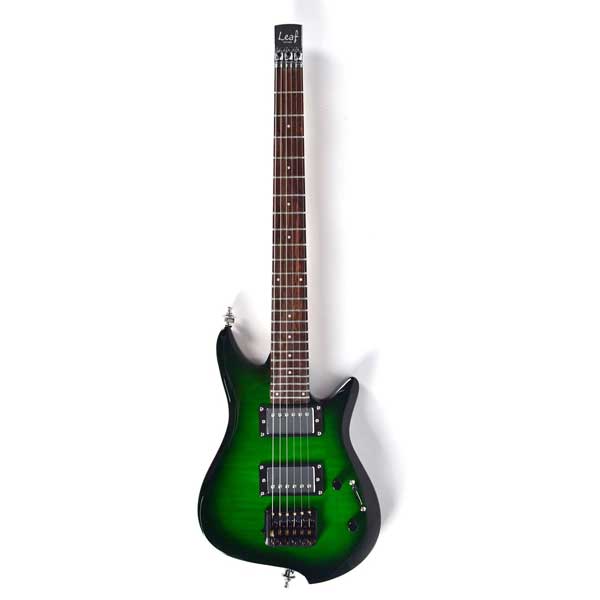
Estimated Price: $395
Pickup Configuration: Combination of Neck Pick-up:LIGHTNING LH-N Aluminum-nickel-cobalt pickup (Switchable single coil pickup) and Bridge Pick-up:LIGHTNING LH-B Aluminum-nickel-cobalt pickup (Switchable single coil pickup) Bridge: Special Adjustable modular bridge for update and exchange Scale Length: 25.5 Inches/648 MM Body Material: Mahogany Neck: Maple
My Review: I like the design of this guitar and overall looks. The pickups and playability really good for the price range. The wood and overall build are very good. A really great value buy if you like a compact travel guitar without sacrificing playibilty and tone.
Key Specs and Features: This instrument has a combination of pickups consisting of 1 Neck Pick-up:LIGHTNING LH-N Aluminum-nickel-cobalt pickup (Switchable single coil pickup) and 1 Bridge Pick-up:LIGHTNING LH-B Aluminum-nickel-cobalt pickup (Switchable single coil pickup).
Target Customer: Anyone interested in a good looking budget Headless Guitar.
Bottom Line: I would recommend this guitar if you have a very low budget.
6. Boden Original 8 Black
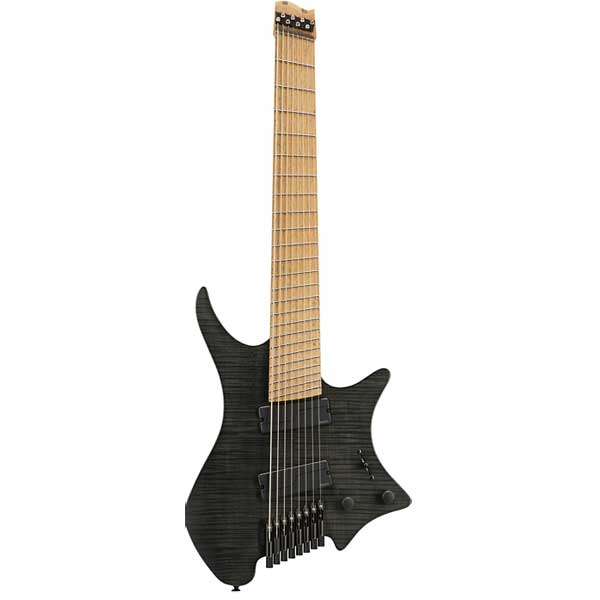
Estimated Price: $2395
Pickup Configuration: HH pickup configuration with 3-way pickup selector, neck, neck and bridge in parallel, and bridge Bridge: Strandberg EGS series 5 fixed bridge & string lock Scale Length: Long scale: 28” (8-string) Body Material: Swamp Ash with 4A Flame Maple top Neck: Roasted maple neck Fret Count: 24 Stainless Steel frets Fretboard Radius: 20″ Country of Origin: Indonesia
My Review: I’ve been playing this guitar for many years now and I have to admit, I have found absolutely nothing to complain about. The sound is dynamic, balanced and the neck is very fluid and ergonomic. Despite it having 8 strings, it is considerably light and comfortable. It is my first 8 string guitar and I’ve mainly purchased it because I just had to have a Strandberg Guitar and if I could get more strings on it, why not. It felt a bit weird switching to an 8 string in the first week, especially when playing chords, but soon adapted to it. Having the 2 additional strings instantly made me rethink the instrument overall, as they offer completely new possibilities.
I’ve initially used the E – B – E – A – D – G – B – E bottom-down tuning, which is very useful to quicker translate chords you’re used to playing as a 6 or 7 string guitarist, but then went more adventurous and played around with other configurations. The EndurNeck makes it very efficient to reach that 8 string, while also playing chords on the higher strings and the pickups do a great job at accurately capturing and rendering the frequency spectrum. I quite like the neutral black look of it and the paint holds up really well but might change it to a swirl, or painted body in the future. Not to mention how groovy you can get with bass techniques like thumbing, while at the same time being able to express a wide range of harmonic content.
Key Specs and Features: This amazing 8 string Strandberg Boden Original electric guitar features a Swamp Ash body, with a Roasted Maple neck built in Indonesia. The pickup configuration is HH with a 3-way pickup selector – neck, neck + bridge in parallel + bridge. It has 24 frets, with a fretboard radius of 20’’ and a 28’’ long scale. It also has a patented Strandberg EGS series 5 fixed bridge & string lock.
Target Customer: Anyone interested in the best ergonomic 8 string guitar ever made. If you’re looking to jump from a 6 string, or a 7 string to an 8 string, then this guitar is for you.
Bottom Line: It’s a really well made 8 string guitar, with lots of extra features compared to other 8 string guitars out there and if you like the headless look, then I’m sure you’ll be happy with this purchase.
7. Legator Ghost Performance 7 (Best 7 String Headless)
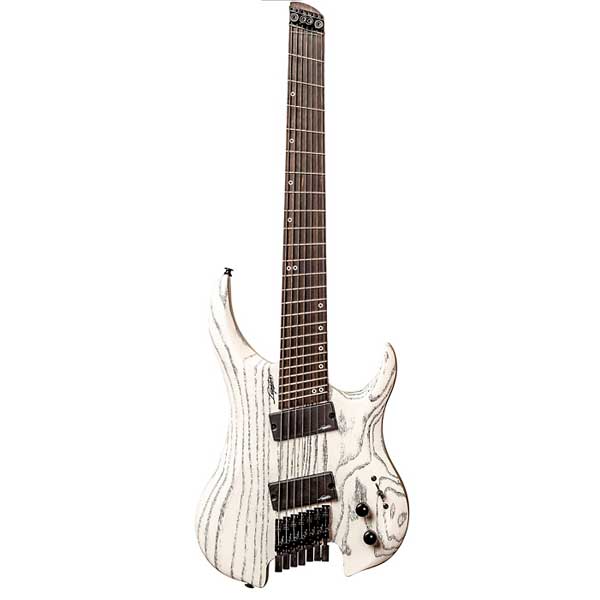
Check Guitar Center Price
Estimated Price: $1000
Pickup Configuration: HH, Passive Neck + Bridge: Alnico. Bridge: Legator Headless Monorail Bridge with a Legator Single Saddle Monorail Scale Length: Multi-scale 25.5–27 in. Body Material: Double cutaway Solid Ash Body, with Polyutherane finish Neck: 1-piece Maple with a Modern D shape and Satin Poly Finish Fretboard: Purpleheart Fret Count: 24 Fanned Frets, Medium Jumbo Country of Origin: South Korea
My Review: This Legator Ghost Performance 7 Multi-Scale Electric Guitar White Ash is the perfect 7 String Headless Guitar option for Trash Metal players. While it has received a lot of critiques, I find it useful for Trash Metal particularly because of the cons. The frets are not as leveled or polished and the pickups sound quite messy, but again, the messy sound is characteristic for Trash Metal riffs.
Key Specs and Features: Legator Ghost Performance 7 Multi-Scale Electric Guitar White Ash features an Alnico HH, Passive Neck + Bridge configuration, with a Legator Headless Monorail Bridge, that has a Legator Single Saddle Monorail. The body is a Double cutaway Solid Ash Body, with Polyutherane finish and the neck is made out of a 1-piece Maple with a Modern D shape and Satin Poly Finish. Manufactured in South Korea, it has a multi-scale 25.5–27 in scale length, with 24 Fanned Frets, Medium Jumbo, and a Purpleheart Fretboard.
Target Customer: Due to its overall aggressive and muddy tone, it’s most appropriate for Trash Metal players.
Bottom Line: I would definitely recommend this guitar for aggressive and noisy metal sounds. It may be good for other styles too, but in that case, the pickups, leveled and polished frets, as well as other minor details, which eventually add up, would need to be improved.
8. JAMMY MIDI Guitar (Best MIDI Headless Guitar)
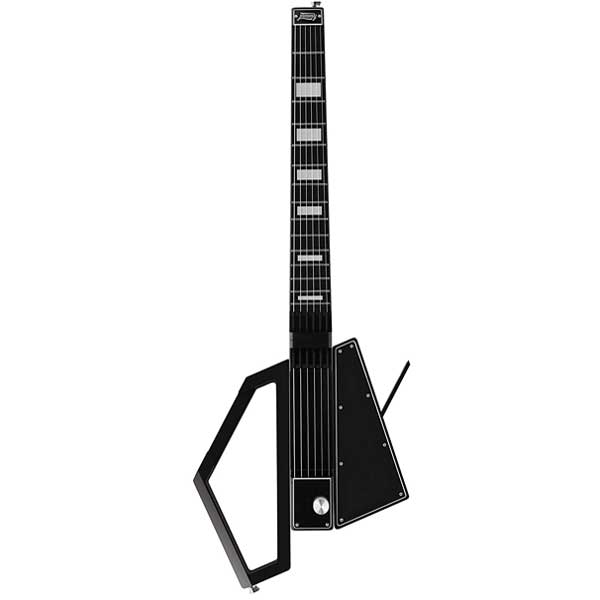
Estimated Price: $500
Pickup Configuration: MIDI Scale Length: N/A Supported Software: Garage Band, Ableton, Logic Pro, Reaper, Cubase, and other major DAWs Color: Black Fret Count: 15 Country of Origin: China
My Review: I find the concept of this guitar really interesting and certainly useful, especially if you’re a guitarist looking to compose music via MIDI. It comes with a really cool app, where you can change tunings, select capo, sounds, etc. You can connect your guitar to your main DAW. It’s nice that is wireless, as that makes things more comfortable, however, it doesn’t feel anywhere near a good real guitar neck. But that’s fine, it’s not meant to be for performance. It’s also portable, so that’s a huge advantage if you’re traveling.
Key Specs and Features: The JAMMY MIDI Guitar App-Enabled Digital Guitar, MIDI Controller has a MIDI pickup configuration and it’s supported on all major DAWs, including Garage Band, Ableton, Logic Pro, Reaper, Cubase, etc. It comes in Black, it’s manufactured in China and has a total of 15 frets.
Target Customer: It’s targeted towards Audio/Music producers and Composers, with a background in guitar performance.
Bottom Line: If you’re an audio/music producer and composer, who doesn’t like using MIDI keyboards, then this may work very well for you. Being a keyboard player myself, as well as a guitarist, I’ve also noticed how coming up with ideas using JAMMY puts me in a different creative mindset. The guitar is the closest instrument to my heart and being able to orchestrate synths, strings, or even drums, by playing the guitar, not only makes things easier but also pushes me to generate ideas differently compared to using a MIDI keyboard.
Popular Related Article: 17 Distortion Pedals You Need To Know About
9. ZA6 Kiesel Zeus (Best Headless Acoustic Electric Guitar)
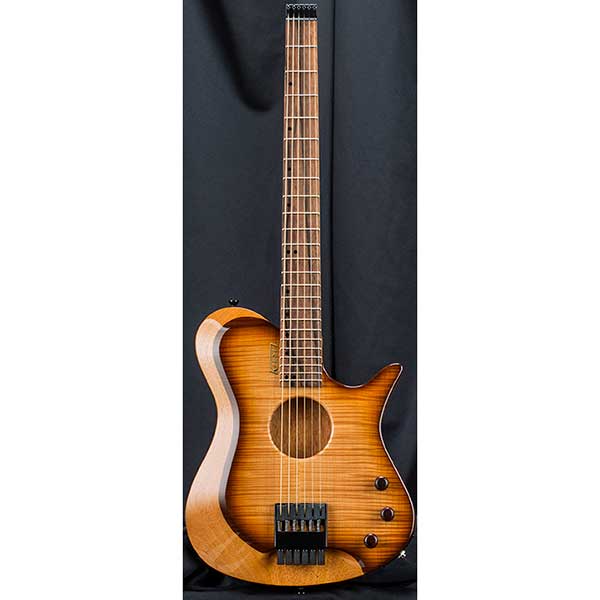
Check Kiesel Guitars Price
Estimated Price: $1550
Pickup Configuration: LR Baggs Element Acoustic Bridge: Hipshot hardtail Scale Length: 25.5’’ Body Material: Mahogany with spruce top Neck: Tung-oiled mahogany with 2-way adjustable truss rod and dual carbon-fiber rods for additional strength & stability Fret Count: 24 stainless steel medium-jumbo, .103 wide X .048 tall Fretboard Radius: ebony, 14″ Country of Origin: USA
My Review: I have to say, this guitar sounds a good bit different then most electric-acoustic guitars out there, but in a good way. Its a dream to have an acoustic headless guitar that is easy to hold and flexible to play, especially when soloing. The aesthetics are incredible, although I would’ve preferred if the Kiesel logo was more subtle like the Strandberg logo is, this is just my subjective opinion. It is ideal for singers/songwriters and due to its small body, it feels exactly like an electric guitar, but with an acoustic tone. I personally really like the differences in sound it has and the fact that you can play fast, easily reaching the 24th fret, which is not something so simple to do on most acoustic electric guitars
Key Specs and Features: This American ZA6 Kiesel Zeus Headless has beautiful specs, where the body is made out of Mahogany with a spruce top. There are a total of 24 stainless steel medium-jumbo, with a scale length of 25.5’’. The pickup configuration consists of LR Baggs Element Acoustic, with a Hipshot hardtail bridge. The neck is made of Tung-oiled mahogany with 2-way adjustable truss rod and dual carbon-fiber rods.
Target Customer: If you like the idea of having a headless acoustic guitar in your collection, then this guitar is for you.
Bottom Line: This instrument is really good if you’re interested in having a versatile headless electro acoustic. It’s really advantageous to be able to play it with such commodity and there aren’t many brands out there offering this level of comfort and sound, for an acoustic electric guitar.
10. Strandberg Boden Classic 6 Trem
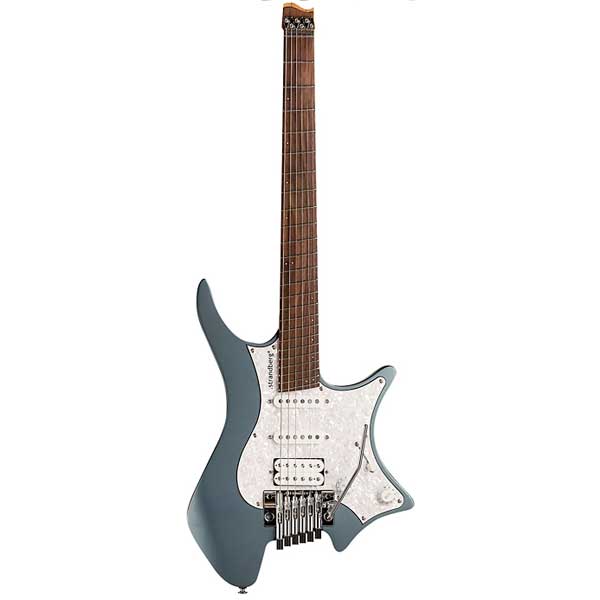
Estimated Price: $1495
Pickup Configuration : Strandberg Signature Humbucker Bridge and Two Vintage-Flavored Single-Coil Bridge: Strandberg Signature EGD Series 5 Tremolo Bridge and String Locks Scale Length: Long Scale 25.5’’ and Short Scale 25” Body Material: Solid Alder Neck: Roasted Maple with Carbon Fibre Reinforcement Fret Count: 24 Maple or Pau Ferro Fretboard Radius: 20’’ Country of Origin: Indonesia
My Review: Strandberg is one of the most innovative brands of electric guitars, making their products some of the best for the modern guitar player. While this particular model is a stock version, part of the classic series, it is the best value in terms of money and quality. Due to its headless design, it’s much lighter than your average electric guitar and its overall dark tone makes it perfect for guitarists who like to be expressive in their playing. The original EndurNeck design just makes it so much more ergonomic, while also promoting a more correct playing position. Unlike most guitars, the tuning actually takes place at the guitar’s body, rather than at the end of the neck, which I’ve found to be a much more reliable and flexible system.
Key Specs and Features: The Boded Classic 6 Trem is the most affordable version Strandberg has and it is available with a solid alder body. The neck is made of roasted maple with carbon fiber reinforcement and 25 frets on the maple or pau Ferro fretboard. Because of its triangular shape, with a diagonal line for the thumb design, plus its overall lightness (approximately 2,4 kg), the guitar is highly ergonomic and easy to play.
It has a satin finish which gives it a very luxurious feel and a Strandberg designed humbucker bridge pickup with two vintage-flavored single-coil pickups. The exact pick-up configuration is H-S-S where the neck and middle both have a custom OEM Strandberg single coil, while the bridge has a custom OEM Strandberg humbucker. Master Volume and Mastertone are also built-in, with a 5-way pickup selector consisted of Bridge, Middle and Bridge, Middle, Neck and Middle, and Neck. The original hardware is plated with chrome with original luminary green side dots and inlays and a Strandberg EGS series 5 tremolo bridge & string locks.
Target Customer: If you’re a fan of guitar players such as Plini, David Maxim Micic, Jakub Zytecki, Tosin Abasi, or Aaron Marshall, or just want a great value headless, then this guitar is for you. They’ve all used it at some point, due to its versatility in sound, looks, and overall playability.
Bottom Line: While it’s the cheapest guitar Strandberg has on the market, being a stock model, this instrument is flawlessly designed and may very well be a lifetime investment. It is not particularly cheap, but it’s still the best headless guitar for the money in my opinion.
Popular Related Article: 22 of Our Favorite Guitar Amps
11. Boss V-BDN VG-Strandberg
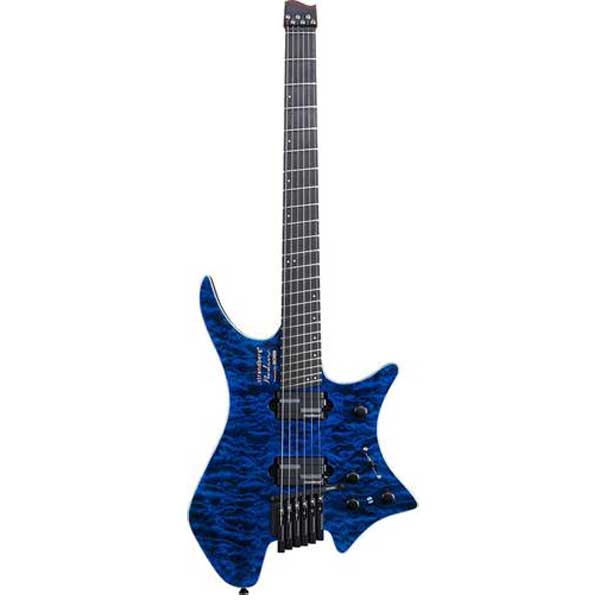
Check Guitarguitar Price
Estimated Price: $5190 Pickup Configuration: Mode selector; 5-way switch, modeled humbucking and single-coil pickups. Bridge: EGS pro 4 tremolo bridge & string locks Scale Length: 25.5″ – 25″ Body Material: Baswood Neck: Roasted maple EndurNeck Fret Count: 24, stainless steel Fretboard Radius: ebony, multiscale, 20″
My Review: This amazing guitar comes with the same benefits and features a Strandberg guitar has, only this time it has been merged with specific guitar modeling techniques developed by Boss. It features switches that allow you to change the tuning, without having to traditionally do it.
Key Specs and Features: Boss V-BDN VG-Strandberg is the result of a fruitful partnership between Strandberg Guitars and Boss. The body is made of Baswood, featuring the ergonomic roasted maple EndurNeck, patented by Strandberg. It has 24 frets, stainless steel with an ebony, 20’’ multiscale fretboard radius. The bridge is an EGS pro 4 tremolo with strings lock and, despite all the electronics, it weighs only just above 5 pounds. The unique pick-up configuration has a mode selector and 5-way switch, to provide access to the onboard standard pickups, modeled humbucking and single-coil pickups, bass, sitar, acoustic guitars, and synth tones.
Target Customer: I’d say this guitar is mainly targeted towards musicians who play experimental music, but it’s not limited to this. It can be very well used in pop, especially if that entails live music or just generally to create orchestrations and productions of various sounds. With this beauty, the sky is the limit.
Bottom Line: In many ways, I feel like this is the future of guitars, and coming from a music technology background, I surely hope these initiatives keep on progressing. The ability to generate different instrument sounds, while being expressive, not only shifts the role of a guitarist in a band but also allows for the musician within to explore creative and compositional ideas, using the familiar approach of performing on an instrument. Surely, one can make the case that that would be easily achieved on a MIDI keyboard, but the difference is in the little details. I’ve personally found it much easier, flexible, and efficient to use instruments that support the performance element more, rather than post-production programming, regardless of the advanced expertise I have in that, as a qualified Audio Specialist.
12. Steinberger (GM) GM4T w/TransTrem (Best Rock/Fusion)
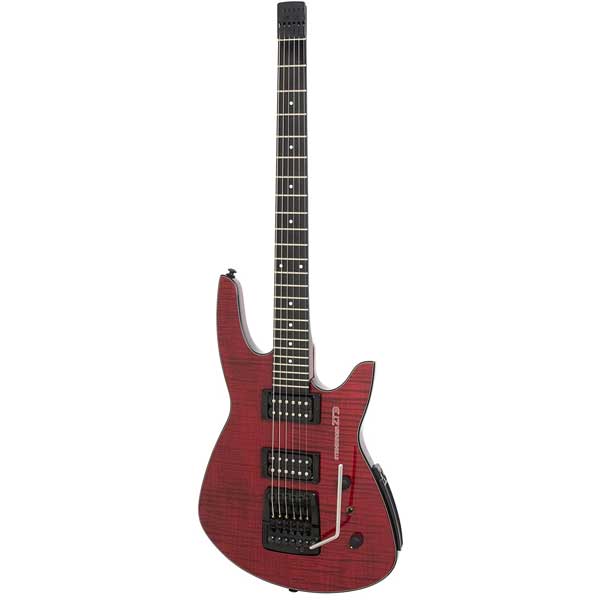
Estimated Price: $2000
Pickup Configuration: 2 single coil pickups and 1 humbucker pickup Bridge: Steinberger S-Trem, Steinberger TransTrem, Steinberger vibrato Scale Length: 25.5 inches scale-length Body Material: alder body, maple body Neck: Carbon Fiber Fret Count: 24
My Review: This guitar is a pure work of art and it’s no wonder. Ned Steinberger is the man who widly gets credit in terms of the whole headless guitar industry inception. Released in 1988, it still is the best of the best when it comes to rock/fusion, as it’s the full embodiment of the 80’s guitar tones. However, due to its solid body, it doesn’t quite offer the same weight benefits as many of the other headless guitars discussed, as it’s pretty much just as heavy as a normal headstock electric guitar.
Key Specs and Features: The Steinberger (GM) GM4T w/TransTrem is an ideal guitar for rock/fusion players. It features 2 single coil pickups and 1 humbucker pickup with a bridge that has Steinberger S-Trem, Steinberger TransTrem, Steinberger vibrato. The body Is alder body, maple body with a carbon fiber neck. There are a total of 24 frets, with a sale length of 25.5 inches.
Target Customer: If you want the absolute ultimate sound in terms of the 80’s guitar scene while having the headless look, then this guitar is ideal.
Bottom Line: While Steinberger guitars haven’t been used a lot after the ’80s, with a few exceptions, they still remain and in particular this model, some of the most beautiful guitars ever built.
Popular Related Article: 17 Awesome Fuzz Pedals of All Price Ranges
13. HH2 Allan Holdsworth
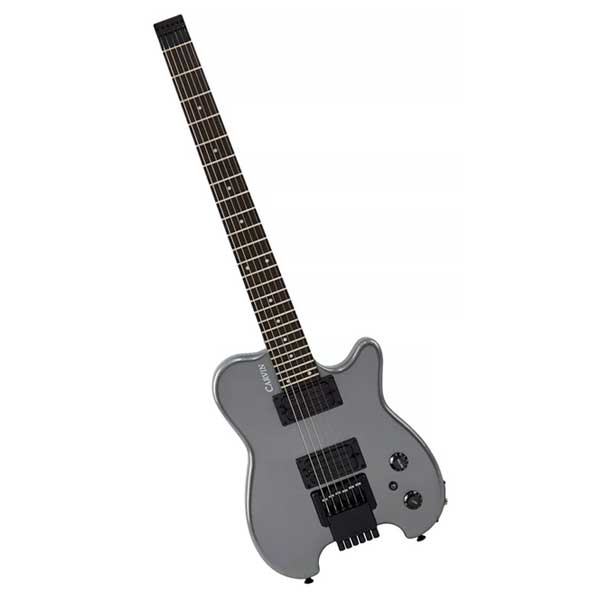
Check Music Radar Price
Pickup Configuration: Kiesel Holdsworth Passive humbuckers Bridge: Hipshot; optional Hipshot/Kiesel Tremolo System Scale Length: 25.5’’ Body Material: Alder body with Kiesel logo; optional chambering Neck: set-in Eastern hardrock maple with 2-way adjustable truss rod and dual carbon-fiber rods for additional strength & stability Fret Count: 24 stainless steel jumbo, .108 wide X .055 tall Fretboard Radius: 20’’ Country of Origin: USA
My Review: Allan Holdsworth was truly one of the most innovative guitarists and musicians ever and this guitar is really a ‘’beautiful machine’’, to quote the master himself. The chambered body along with the vintage-ish pickups make it very dynamic and full of color. It’s extremely fluid and easy to play and for these reasons, I would mostly recommend it for soloing or intervallic chordal playing.
Key Specs and Features: Allan has worked with Calvin Guitars (now Kiesel) for many years in realizing the HH2 Allan Holdsworth guitar. Originally from the USA, the instrument features an alder body and optional chambering (highly recommended). The eastern hardrock maple neck is strong and stable, while fro the neck you have the option of choosing between the Hipshot or Kiesel tremolo systems. There are a total of 24 stainless steel jumbo frets and the pickup configuration features the original Kiesel Holdsworth passive humbuckers.
Target Customer: Here’s a tough one. The main target customer, in this case, would be someone who’s a fan of Allan, but because his music is so unique, there isn’t really a wider category in which to fit the customer target, other than this. Having said that, If you love Allan’s music, then owning this beautifully designed guitar is going to help, but it shouldn’t be purchased to sound like him, but rather to be used as a complementary tool in finding your own voice.
Bottom Line: The overall value in relation to price is exceptional for this guitar and I couldn’t recommend it more. While initially designed for a very niche type of music, the final result translates well for most genres.
Popular Related Article: Electric Guitars Under $1000
14. Steinberger Spirit GT-Pro Deluxe
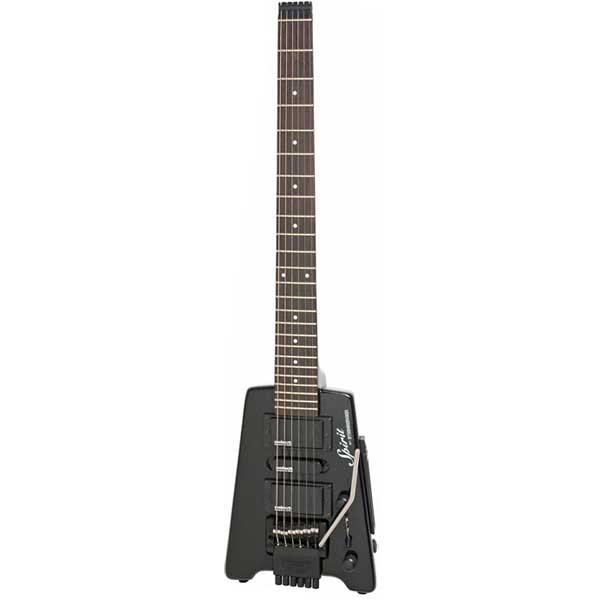
Estimated Price: $400
Pickup Configuration: Pickup Bridge: Steinberger Guitar Humbucker, Pickup Middle: Steinberger Guitar Single-Coil, Pickup Neck: Steinberger Guitar Humbucker Bridge: 40: 1 Direct Drive R-Trem Tremolo Scale Length: 25 – 1/2″ Body Material: Maple Neck: Hard Maple Fret Count: 24 Fretboard Radius: 14”
My Review: The genius Ned Steinberger designed this guitar to be a useful headless travel guitar and in honor of that, it just has to be the best travel headless guitar out there. I have to say, I like this guitar a lot. Great playability, it is comfortable and the pickups are good quality. It’s a travel instrument, but it doesn’t really compromise on sound and could definitely be used on stage or even in professional recordings. There is a slight disadvantage in that you can’t use regular strings with it, but apart from that, this guitar is great.
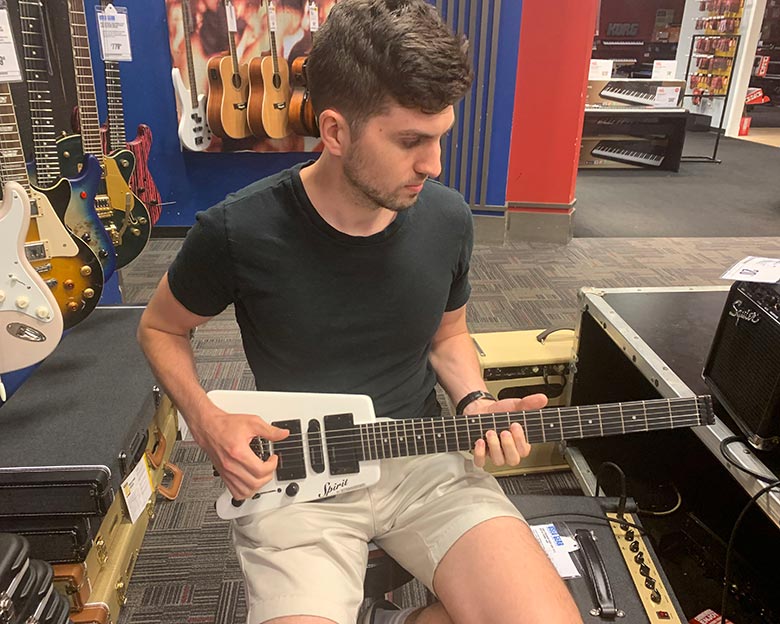
Key Specs and Features: The Steinberger Spirit GT-Pro Deluxe Electric Guitar comes with a Maple Body and Hard Maple Neck. The pickup configuration consists of a Steinberger Guitar Humbucker Bridge, Steinberger Guitar Single-Coil Middle Pickup, and a Steinberger Guitar Humbucker Pickup Neck. It has a Scale Length of 25 – 1/2” and 24 frets, with a 14” Fretboard Radius.
Target Customer: Musicians who are traveling or who want a good value Headless Guitar. If you want a great sounding portable headless guitar, then this is for you.
Bottom Line: If you’re on a tight budget this is the best cheap headless guitar that’s still pretty good quality so I definitely recommend it.
Popular Related Article: Top 17 Electric Guitars For Metal
15. Ibanez EHB1505MS 5-String Headless Bass
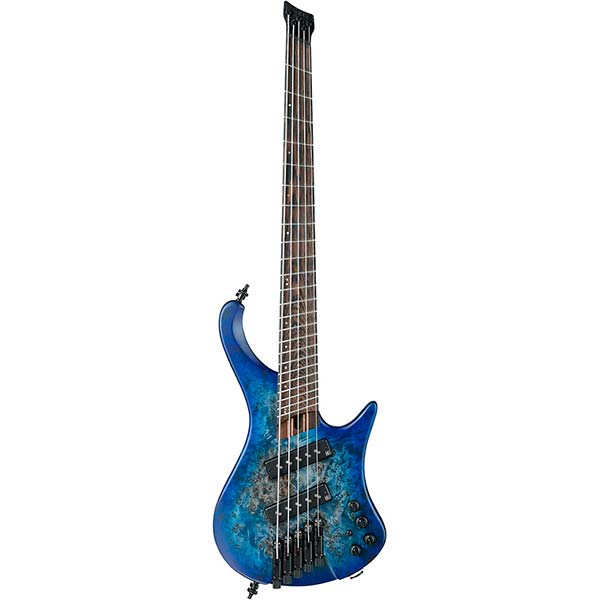
Estimated Price: $1700
Pickup Configuration: Nordstrand Custom Big Split pickups Bridge: MR5HS bridge (18mm string spacing) Scale Length: Body Material: Poplar Burl top/Selected lightweight African Mahogany body Neck: EHB5 9-piece Panga Panga/Walnut neck with Graphite reinforcement rods Fretboard: Highly durable stainless steel frets
My Review: The Ibanez EHB1505MS 5-String Multi-Scale Ergonomic Headless Bass Pacific Blue Burst Flat has the same features as the Ibanez EHB1506MS 6-String Multi-Scale Ergonomic Headless Bass Black Ice Flat mentioned earlier, except with 5 instead of 6 strings.
Key Specs and Features: The Ibanez EHB1506MS 5-String Multi-Scale Ergonomic Headless Bass Pacific Blue Burst Flat features a Poplar Burl top/Selected lightweight African Mahogany body, with a 9-piece Panga Panga/Walnut neck. It has Highly durable stainless steel frets and Bound Panga Panga fretboard with Abalone off-set dot. It has an MR5HS bridge (18mm string spacing), with a Nordstrand Custom Big Split pickup configuration.
Target Customer: Modern progressive metal, metal, and jazz players.
Bottom Line: Overall this bass offers great tones, combined with a lovely and comfortable playability, as well as superb looks. This is an excellent choice for a 5 string Headless Bass Guitar.
16. Marconi Lab Ego Thunder 2k17
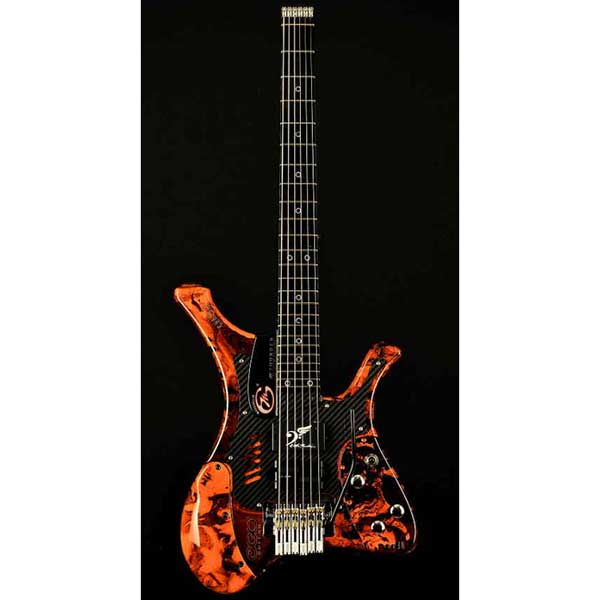
Check Marconilab price
Estimated Price: $3200
Pickup Configuration: Neck pickup: A Little Thunder Black + Bridge pickup: Lace alumitone Deathbucker Black Bridge: Tremolo-6 strings- chrome Body Material: Alder Neck: Maple black finish with AVS (Asymmetric Variable Shape) Frets: 6105 type Fretboard Radius: Compound Radius 10″-16″ Country of Origin: Italy
My Review: Not usually a fan of passive pick-ups but this guitar really challenges that! Sounds really unique in its own way and the Little Thunder pick-up has a nice feature where you can use it to switch for lower tones. The tremolo bar is really on point and easy to maneuver, while the design is modern and smartly build to reach higher notes effortlessly. The guitar is extremely fluid and easy to play.
Key Specs and Features: This incredible machine features a pickup configuration designed as a Neck pickup: A Little Thunder® Black + Bridge pickup: Lace alumitone Deathbucker Black, an Alder body with a Maple black finish with AVS (Asymmetric Variable Shape). The type of the frets are 6105 and fretboard radius is compound, 10’’ to 16’’. Made in Italy, it features a Tremolo-6 strings- chrome bridge.
Target Customer: If you’re looking for a uniquely looking headless guitar with a hybrid set of details in the build, then this guitar is for you.
Bottom Line: A really good take on a headless guitar from the Marconi Lab – Highly recommended.
17. Rick Toone USM-PRO
Check Modern Mojo Guitar Price
Estimated Price: $11000
Pickup Configuration: OEM Custom DiMarzio Pickups Bridge: Patented Intonation Cantilever Bridge Scale Length: Multiscale / N/A Body Material: Carbon Fiber and Laminated Birch Neck: Single Billet Machined Aircraft Aluminium Fret Count: 24, Stainless Steel Country of Origin: USA
My Review: This guitar is truly a monster, in the best sense. The overall build and feel are truly unique, while the sound is crisp and beautifully articulate. Rick Toone is really and inventor in the guitar world and always comes up with ways to push the boundaries of what an instrument can be.
Key Specs and Features: The Rick Toone USM-PRO electric guitar, features a pickup configuration of OEM Custom DiMarzio Pickups, with a Patented Intonation Cantilever Bridge. It has a Multiscale scale length, with 24 Stainless Steel frets. The body material is Carbon Fiber and Laminated Birch with a Single Billet Machined Aircraft Aluminium neck, made in the USA.
Target Customer: Just like the Teuffel Guitars Nickel BirdFish, this guitar is aimed at people with a higher budget that seek to invest a cutting edge instrument, in the guitar sector.
Bottom Line: If you are an advanced player and wish to find that special guitar to express a full range of techniques and sounds, then this is easily one of the best headless guitars out there. It does ultimately come down to your playing in order to achieve that, but having a cutting edge guitar certainly is an important factor.
Choosing a Headless Guitar (Buying Guide)
So, if you are interested in going headless, there are a few crucial aspects to consider, so as to make an informed decision if this is the best idea or not for your needs. While buying a headless guitar may sound like an edgy thing to do, thus making the decision itself more subjective, there a few objective and technical aspects to look for:
So, if you are interested in going headless, there are a few crucial aspects to consider, so as to make an informed decision if this is the best idea or not for your needs.
While buying a headless guitar may sound like an edgy thing to do, thus making the decision itself more subjective. Let’s talk about what features to look for in a headless guitar .
Technical Aspects to Look for in a Headless Guitar
- They are much lighter than the average electric guitars. If you take any other headstock electric guitar, it will weigh an average of 3.6Kg, while a headless guitar will only weight around 2.5Kg. This makes them more kind to your body over time and considerably easier to hold.
- They are significantly more ergonomic, especially if we are to take into account the EndurNeck design from Strandberg.
- They stay longer in tune. While there are multiple factors that determine if the guitar’s tuning is stable or not, generally, the tuning systems available on headless guitars are much more reliable and durable.
- It is much faster to change the strings on a headless guitar.
- On average, headless guitars have a much better sustain.
- They are very portable!
- There are generally no noise issues.
- As a bonus, having a smaller body also implies less wood, making them more environmentally friendly.
Now the aspect, being mostly a subjective factor, can’t really be analyzed. It simply comes down to whether or not you like the looks of a headless guitar or not and I don’t want you to take this lightly! If a new instrument, as innovative as it may be, doesn’t make you feel good by the way It looks, it is almost irrelevant if the technology itself is better.
Once you’ve decided whether or not a headless guitar is for you, there are of course many other important elements to look at, such as understanding the specs of each guitar. I will briefly go through each of them.
In many ways, the bridge determines the action of the strings, thus also influencing the playability. It is an important part of the hardware that has the main purpose of holding the strings to the body of the guitar. It contributes greatly to the overall vibration and amplification of the strings.
My personal favorite bridges for headless guitars are the patented Intonation Cantilever Bridge by Rick Toone, the Tremolo-6 strings- chrome on the Marconi Lab Ego Thunder 2k17, the custom bridge designed for the Teuffel Guitars Nickel BirdFish and finally the Strandberg EGS series 5 fixed bridge & string lock.
There are two main types of electric guitar bodies and those are solid and chambered. The chambered body is around 25% lighter than the solid one, so look for chambered, if you’re aiming at a really light headless guitar. Another thing to consider is the difference in sound they add to the guitar. I much more prefer the chambered body, just because it sounds more full, resonant, and articulate in my opinion, but the differences are really subtle.
Now, the most common types of wood used for Bodies are Mahogany, Swamp Ash, Maple, and Alder. In terms of weight, they weigh pretty much the same, but the sounds differ considerably. Mahogany tends to bring out the low mids more, which does make sense why it’s present on guitars which are intended to sound heavy and be more metal riffs oriented. Swamp Ash tends to be richer in high and also quite full in the low end. This to me is the perfect combination since in my playing I love to incorporate intervallic chordal playing, which sounds immersive and somewhat dark, but at the same time have the ability to really attack during solos. For this reason, my guitar has a chambered, swamp ash body with a maple top, which is the same build the Strandberg Boden Plini Edition has. Because maple is more toward middle frequencies, adding that top to the recipe is exactly the last ingredient in realizing a perfect balanced guitar, like my 8 string Strandberg. Alder bodies tend to soften attacks and be more towards upper mids. There are many great guitars with alder bodies in our list, such as Strandberg Boden Classic 6 Trem, HH2 Allan Holdsworth, Steinberger (GM) GM4T w/TransTrem, Teuffel Guitars Nickel BirdFish, and Marconi Lab Ego Thunder 2k17.
Aim for the body that works with your needs, as it’s best to get the best result acoustically. However, if say you find a guitar you love overall, but you can’t change the body to the desired specification, don’t be put off by it. After all, you can always use EQ to compensate.
The main types of frets are stainless steel and nickel frets. I’ve always found stainless steel to feel much better to touch and also bend considerably well, compared to nickel. They last much longer than nickel too, however, nickel does tend to sound brighter, so it all comes down to what you’re after.
The Fretboard Radius
the compound Radius 10”-16″ is by far the cleanest, which is one of the main reasons why Marconi Lab Ego Thunder 2k17 excels on this level.
The two main types of pickups you want to look for when choosing the ideal Headless Guitar are humbucker and single coil.
The Humbucker pickup got its name due to its ability to remove hum, while playing distorted sounds, hence why it is usually preferred by metal or rock players. Single Coil sound brighter and are generally used for cleaner sounds, in styles such as funk, jazz, bluet, etc. In some cases, however, they are used for rock or even metal. It all depends on the other features of the guitar if using single coil for metal, for example, is a good idea or not.
The Single Coil or Humbucker pickups can be passive or active. The main difference between them is the ‘flavor’. Because they don’t use a preamp, passive pickups tend to render a slightly different, more interesting tone. However, they often have the downside of generating a lot of noise, due to their high sensitivity. On the other hand, active pickups are the exact opposite. They render a high degree of control over hum reduction, but in doing so, they reduce the dynamics.
I’ve personally seen guitarists using active or passive pickups in all genres, regardless of the genre they’re playing, so when you’re deciding upon which pickup to choose, you should consider the overall build of the guitar and what you like most, in terms of sound.
Type of Strings
There are two main types of strings most commonly used on electric guitars: Nickel and Steel. Nickel is generally best If you want to play warmer, smooth melodies. They are much richer in tone whereas steel is brighter, resulting in an overall higher presence.
Conclusion:
Finally, if by the end of this article you have not decided which headless guitar to purchase, put everything on paper and devise a balance of pros and cons that work for you specifically, based on the information provided and further research. Test the guitars yourself, as there’s no better way of telling which one’s the best for your needs.
When talking about headless guitars, there’s a huge list of what can be classified as best and this article covers only some, but it should hopefully be enough to help you in finding the Best Headless Guitar that fits your own particular requirements as a Musician.

My name is Chris and I’ve had a passion for music and guitars for as long as I can remember. I started this website with some of my friends who are musicians, music teachers, gear heads, and music enthusiasts so we could provide high-quality guitar and music-related content.
I’ve been playing guitar since I was 13 years old and am an avid collector. Amps, pedals, guitars, bass, drums, microphones, studio, and recording gear, I love it all.
I was born and raised in Western Pennsylvania. My background is in Electrical Engineering, earning a Bachelor’s degree from Youngstown State University. With my engineering experience, I’ve developed as a designer of guitar amplifiers and effects. A true passion of mine, I’ve designed, built, and repaired a wide range of guitar amps and electronics. Here at the Guitar Lobby, our aim is to share our passion for Music and gear with the rest of the music community.
3 thoughts on “17 Best Headless Guitars in 2024 (All Price Ranges)”
This is a detailed analysis of some of the best headless guitars. Over the years, i have developed a desire for this type of guitar having observed the sound output from one of the best known African soloist artist from the Democratic Republic of Congo. I will now critically re examine the analysis and possibly come with one or two types for purchase. Thanks for enlightening us on this critical area of entertainment.
I’m surprised to not see any NK guitars in here. I have an NK multi-scale 7 string headless and I think the “bang for the buck” is spectacular. If you’ve never played one, you should give one a try.
I’m definitely interested in checking out some of these headless guitars!
Leave a Comment
Save my name, email, and website in this browser for the next time I comment.

The 10 Best Travel Guitar Options in 2024 [Acoustic & Electric]
![travel guitar whammy The 10 Best Travel Guitar Options in 2022 [Acoustic & Electric]](https://producelikeapro.com/blog/wp-content/uploads/2022/07/The-10-Best-Travel-Guitar-Options-in-2022-Acoustic-Electric.jpg)
The best travel guitar makes a perfect companion for busy, on-the-go guitarists searching for playability that’s built to move. There are electric options, acoustic options, and even hybrid electro-acoustic travel guitars. Whether it’s for practice and warming up, or full-blown gigging and session work, there is a unique portable guitar for every musician.
What Differentiates “Travel Guitars” from Regular Guitars
Portability is the number one feature of the “travel” guitar, which typically comes in the form of shorter scale lengths, smaller bodies, and lighter weight. Some guitars retain a normal scale length, and thus a regular playing feel, but they’ve been otherwise shrunk down to squeeze into the travel category.
- RELATED: Traveling the World Recording in a Van!
- RELATED: Hit the Road Music: A Traveling Recording Studio
Features to Look for in a Travel Guitar
Other features to look for in a travel guitar are pretty much the same as when shopping for a regular guitar. The first distinction will be acoustic, electric, or electro-acoustic based on your playing style and needs. Travel guitars sometimes have features exclusive to the category, such as built-in headphone outputs for practice. In most cases, however, the right guitar for you shouldn’t be too difficult to determine — you know best!
The 5 Best Travel Guitar Options for Acoustic Players
1. taylor baby taylor.
![travel guitar whammy The 10 Best Travel Guitar Options in 2022 [Acoustic & Electric]_2](https://producelikeapro.com/blog/wp-content/uploads/2022/07/The-10-Best-Travel-Guitar-Options-in-2022-Acoustic-Electric_2.png)
The Baby Taylor series is one of the most popular 3/4-size acoustic guitars ever made. Everything about the design makes it a great choice for beginners because the necks are slim and easy to play. Experienced players can enjoy a Baby Taylor as a travel or practice guitar as well. Options include different top woods and the choice of built-in electronics.
2. Martin Backpacker
![travel guitar whammy The 10 Best Travel Guitar Options in 2022 [Acoustic & Electric]_3](https://producelikeapro.com/blog/wp-content/uploads/2022/07/The-10-Best-Travel-Guitar-Options-in-2022-Acoustic-Electric_3.jpg)
The steel-string Martin Backpacker is one of the best examples of an acoustic travel guitar. It has 15 frets with a 24″ scale length, with a uniquely shaped body that cuts away all of the bulk of a traditional acoustic. This is ideal for anyone prioritizing portability.
- RELATED: Martin Special D Review: A Perfect Mid-Level Acoustic?
3. Traveler Escape Mark III
![travel guitar whammy The 10 Best Travel Guitar Options in 2022 [Acoustic & Electric]_4](https://producelikeapro.com/blog/wp-content/uploads/2022/07/The-10-Best-Travel-Guitar-Options-in-2022-Acoustic-Electric_4.jpg)
The Traveler Escape Mark III offers familiar electric guitar-style playability in an acoustic package with built-in electronics. Highlights include 22 medium frets with a 25.5″ scale length. Active electronics come with volume, bass, and treble adjustments, as well as an aux input and headphone output.
- RELATED: Cordoba Iberia C5 Review: The Best Entry-Level Nylon Guitar?
4. Taylor GS Mini-e Koa
![travel guitar whammy The 10 Best Travel Guitar Options in 2022 [Acoustic & Electric]_5](https://producelikeapro.com/blog/wp-content/uploads/2022/07/The-10-Best-Travel-Guitar-Options-in-2022-Acoustic-Electric_5.png)
The Taylor GS Mini-e Koa is a mid-range travel guitar for serious players. Despite its small size, the guitar’s voice is huge, and even comes with a built-in pickup for electro-acoustic playability. Compact scale length seats this in the travel category, but it’s really just a nice all-around acoustic-electric guitar.
- RELATED: Yamaha APX600 Review: Is This Thinbody Acoustic Worth the Price?
5. Yamaha CSF3M
![travel guitar whammy The 10 Best Travel Guitar Options in 2022 [Acoustic & Electric]_6](https://producelikeapro.com/blog/wp-content/uploads/2022/07/The-10-Best-Travel-Guitar-Options-in-2022-Acoustic-Electric_6.jpg)
A travel guitar in the most traditional sense, the Yamaha CSF3M is a parlor-style acoustic similar to those which traveling guitarists played in the early 1900s. While much more compact than a full dreadnought-style acoustic, these guitars are excellent for the studio or the stage, with a built-in passive undersaddle pickup for amplification.
- RELATED: The 9 Best Acoustic Guitar Pickups
- RELATED: Choosing the Best Pickup for Classical Guitar
The 5 Best Travel Electric Guitar Options
1. travelcaster deluxe electric travel guitar.
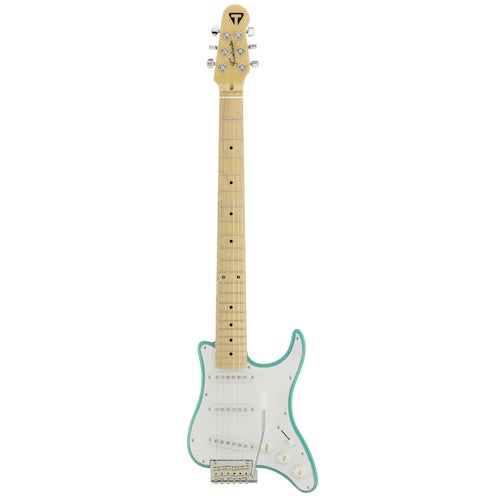
Ever wanted to know what an S-style guitar looked like if everything around the pick guard was gone? Well, here it is! This is a very cool electric mini guitar with a traditional 25.5″ scale length, three single-coil pickups, 5-way pickup selector, and all the appointments of a standard S-type — with much smaller body!
2. Blackstar Carry-On
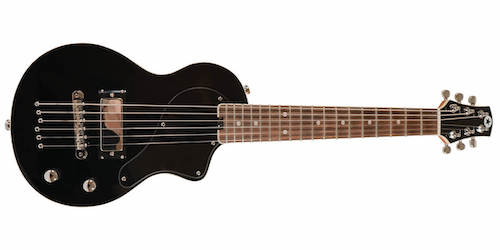
Anything but traditional, the Blackstar Carry-On is an innovative instrument and quintessentially made to move. It features 18 frets on a 20.7″ scale, with a single mini-humbucker with coil-split. The guitar is strung with 12-54 gauge strings to recreate standard scale tension on a very short scale instrument.
3. Steinberger Spirit GT-Pro Deluxe

Steinberger headless guitars debuted in 1979. At the time, and for many years, there was nothing quite like them. They’re amongst the most playable and versatile small guitars around. The Spirit GT-Pro has 24 frets, a 25.5″ scale length, an HSH pickup configuration, 14″ radius, and a tremolo system.
4. Hofner Shorty Travel Guitar
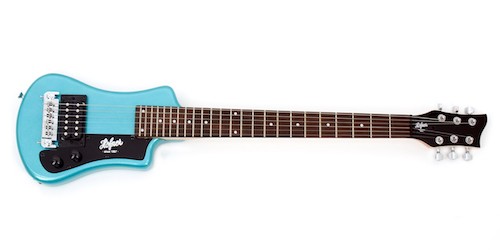
Hofner Shorties came out in the ’80s, aimed at players who didn’t want to miss a moment of practice. The familiar feel is a major selling point for many guitarists, with 24 frets on a 24.75″ scale length. There is a single humbucker with volume/tone controls, and a simple gig back to take on the road.
5. VOX SDC-1 Mini
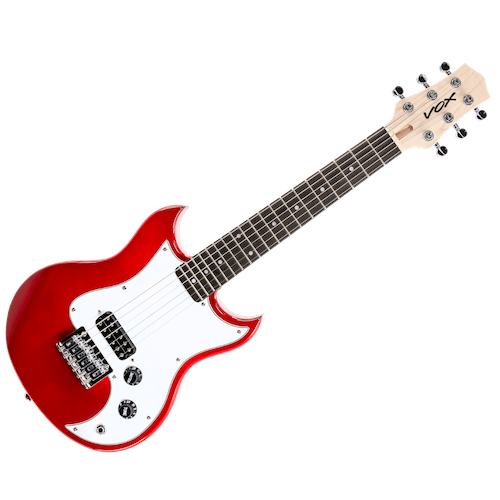
Last but not least, we have the VOX SDC-1 Mini. With 19 medium jumbo frets and an 18.75″ scale, it’s perfect for beginner guitarists, players with smaller hands, or anyone looking to take their instrument with them anywhere.
- RELATED: The 10 Best Acoustic Guitar Strings to Consider in 2023
Leave a Reply Cancel reply
Your email address will not be published. Required fields are marked *

Discover the Innovative World of Present Day Production’s Custom Speakers
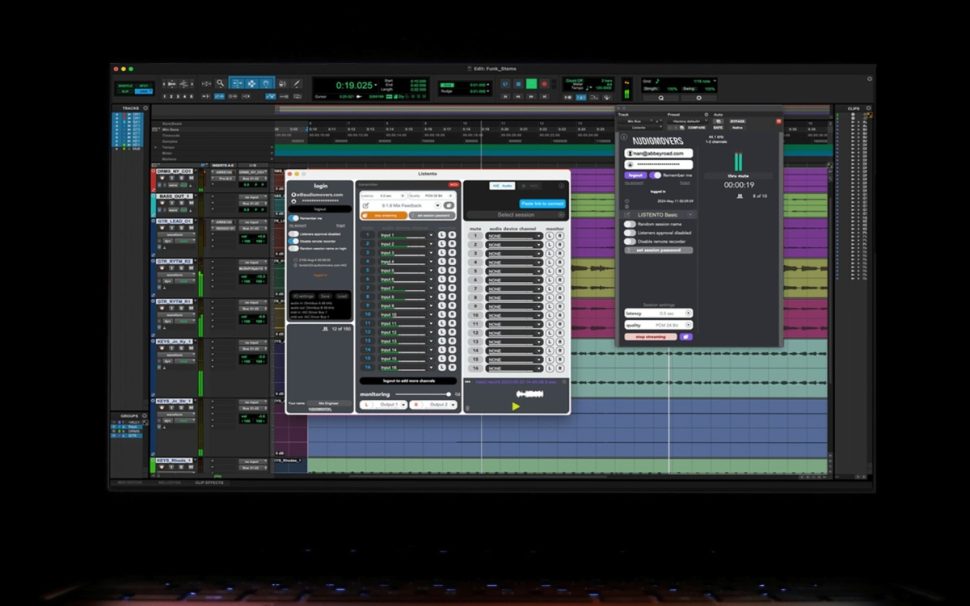
Audiomovers Binaural Renderer for Apple Music Review

Nolly Vs Warren Drum Shootout at The Nave Studio
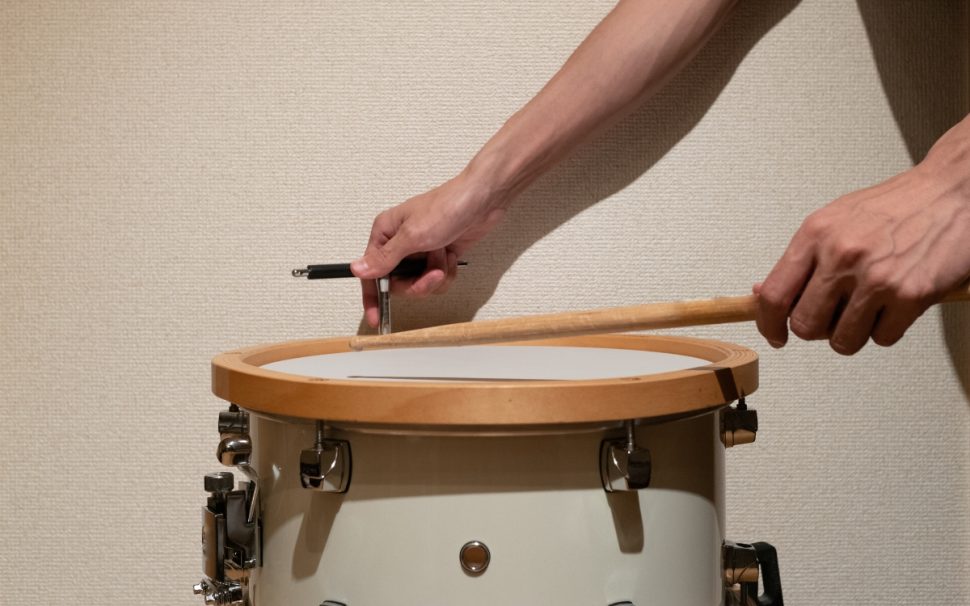
The Best Drum Tuner Options (Tuners & Apps)
- Acoustic Guitar
- Acoustic Treatment
- Audio Interface
- Best Drum Shield
- Cheat sheet
- Compression
- Drum Shield
- Gear Review
- Guitar Pedals
- Home Mixing
- Home Recording
- Home Studio
- Inside the Song
- Microphones
- mixing in the box
- mixing tips
- mixing tricks
- Mixing Vocals
- Music Production
- Plugin Demo
- Pro Mix Academy
- Recording Vocals
- Songwriting
- Synthesizers
- The 5 Best Drum Shield Options for Your Home Studio in 2023
- What Is Time Stretching and When Would You Use It?
Steinberger GT-PRO Deluxe Outfit
Classic Steinberger Design with R-Trem™ System plus Deluxe Gigbag

• Steinberger is the Ultimate Travel Guitar™
• Patented R-Trem™ and 40:1 Ratio Direct-Pull Systems
• Available in Black, Frost Blue, Hot Rod Red, Hot Rod Yellow, White, and Yin Yang Gloss finishes
• Includes Deluxe Gigbag
Steinberger presents the new GT-PRO Deluxe Outfit, the Ultimate Travel Guitar™ featuring the revolutionary Steinberger body design in Black, Frost Blue, Hot Rod Red, Hot Rod Yellow, White, and Yin Yang Gloss finishes. The Steinberger GT-PRO includes the patented 40:1 Ratio Direct-Pull tuning and locking R-Trem™ tremolo systems plus a 3-pc Hard Maple neck with adjustable truss rod for an incredible sounding guitar that’s practically indestructible. The GT-PRO Deluxe Outfit is part of the new Steinberger Spirit Collection and includes a deluxe gigbag.
Revolutionary Steinberger Design
There was nothing like Ned Steinberger’s guitars and basses when they were first introduced in 1979. Today, with their lightweight and headless design, Steinberger guitars are still bold, modern instruments that offer players both a smooth tonal response and rock solid intonation at any position on the neck while giving soloists a more pronounced single note attack not available from typical guitar designs.
The GTR-PRO 6-string electric guitar features the revolutionary Steinberger design with a Basswood body and 3-pc Hard Maple neck for an instrument that resonates as a single piece of wood. For traveling musicians, the GT-PRO is the Ultimate Travel Guitar™. At only 30.25” long, its ergonomic design makes it easy to take anywhere including overhead airline compartments. And thanks to its headless construction and 3-pc Hard Maple neck, the GT-PRO isn’t as sensitive to temperature changes as typical guitars, which makes it virtually indestructible! The neck has a comfortable 1960's style SlimTaper™-D profile, 24 medium jumbo frets, and a 14” radius. A folding leg rest sits compactly on the lower bout of the guitar. A deluxe gig bag is included. An optional hard case is also available.
Patented R-Trem™ Tremolo and 40:1 Ratio Direct-Pull Systems
Steinberger necks provide players slightly extended spacing at the upper frets and can maintain incredibly accurate intonation under intense shredding. With no headstock, the GT-PRO has a Zero Nut Fret with a width of 1.625 that moves up to 2.04” at the 12th fret as the neck subtly widens to 0.42” string spacing at the bridge. The bridge has steel saddles with Steinberger’s patented R-Trem™ Locking Tremolo and 40:1 Ratio Direct-Pull tuning systems. Unlocked, the R-Trem is capable of extreme dive-bombing as well as pull-ups. Locked, the R-Trem acts like a fixed bridge. Since there is no headstock, the weight of the GT-PRO feels more balanced than a typical guitar. Fine tuning adjustments are made at the bridge and string changes can be made fast! The Steinberger GT-PRO is set up at the factory with Steinberger DoubleBall™ 10-46 strings. Plus, with the Single Ball string adopter, you can set also set up the GT-PRO with regular strings.
Versatile Pickups
The Steinberger GT-PRO is powered by Steinberger’s versatile humbucker pickups in the neck (HB-2) and bridge (HB-1) positions along with full-range Steinberger SC-1 single coil pick up in the middle position. Controls include Master Volume, Master Control, and a 5-way pickup selector.
Limited Lifetime Warranty
As part of the Gibson Brands Family of Instruments, the Steinberger GT-PRO Deluxe Outfit comes with a Limited Lifetime Guarantee and 24/7/365 Gibson Customer Service. Visit your Authorized Steinberger Dealer today and bring home a Steinberger GT-PRO Deluxe Outfit!
Steinberger GT-PRO Deluxe Outfit Specifications
Finish: Gloss
Neck Material: 3-pc Hard Maple
Body Top: AAA Quilt Maple Veneer
Body Material: Basswood
Neck Shape: 1960's SlimTaper™; D profile
Fingerboard Material: Engineered Hardwood
Fingerboard Radius: 14"
Frets: 24; Medium-Jumbo
Scale Length 25.5"
Zero Nut Width: 1.625
12th Fret Width: 2.04"
Bridge: Locking R-Trem™ Tremolo System
Saddle Material: Steel
Bridge String Spacing: 0.42"
Tuning System: Patented 40:1 Ratio Direct-Pull
Neck Pickup: Steinberger HB-2
Middle Pickup: Steinberger SC-1
Bridge Pickup: Steinberger HB-1
Master Volume
Master Tone
5-Way Pickup Selector
Hardware: Black
Output Jack: Premium 1/4" Barrel-Style
Strings: Steinberger DoubleBall™ 10-46
Other: Fold Down/Up Leg Rest
Colors: Black (BK), Frost Blue (FB), Hot Rod Red (HR), Hot Rod Yellow (HY), White (WH), Yin Yang (YY)
Includes: Deluxe Gigbag
Weight: 7.0 lbs
Length: 30.25"
Single Ball String Adaptor (#STADG06)
Hard Case (#ST-A0190-BL)
Case UPC = 711106370224
Warranty: Steinberger Limited Lifetime
Website: www.Steinberger.com
Service: 1-800-4GIBSON (1-800-444-2766)
About the Steinberger Spirit Collection
Steinberger—home of the Ultimate Travel Guitar™ presents the new Spirit Collection of electric guitars and basses. Featuring the legendary Steinberger lightweight headless design, patented 40:1 Ratio Direct-Pull tuning system, patented locking R-Trem™ tremolo systems, a deluxe gigbag, Steinberger pickups, and beautiful color finishes.
The Steinberger Spirit Collection features the GT-PRO and “Quilt Top” Deluxe 6-string Outfits, the XT-2 Standard 4-string Bass Outfit, the XT-2DB 4-string bass with DB-Tuner™, and the 5-string XT-25 Standard and Quilt Top Standard Outfits. Each instrument is also available as a left-handed model. And as a member of the Gibson Family of Brands, every Steinberger instrument comes with a Limited Lifetime Guarantee and 24/7/365 Gibson Customer Service. Step into the future with the Steinberger Spirit Collection at Authorized Steinberger Dealers everywhere.

Duane Eddy, twangy guitar icon of early rock, dead at 86
Duane Eddy, a pioneering guitarist who made his debut in the 1950s, has died . The twangy guitarist was 86.
Eddy died of cancer on Tuesday at the Williamson Health Hospital in Franklin, Tennessee, his wife, Deed Abbate, said.
Eddy paved the way for a new generation of guitarists by focusing on the bass strands on the guitar versus the high ones. During his career, Duane sold more than 100 million copies and was inducted into the Rock and Roll Hall of Fame in 1994.
"I had a distinctive sound that people could recognize and I stuck pretty much with that. I’m not one of the best technical players by any means; I just sell the best," Eddy told The Associated Press in a 1986 interview. "A lot of guys are more skillful than I am with the guitar. A lot of it is over my head. But some of it is not what I want to hear out of the guitar."
TWO-TIME 'SURVIVOR' CONTESTANT KEITH NALE DIES AT 62
Eddy's debut album, "Have Twangy Guitar Will Travel," was released in 1958. This was when he coined his distinctive "twang" that was heard throughout his entire career and went on to influence George Harrison and Bruce Springsteen .
READ ON THE FOX NEWS APP
Eddy's style of music was also highlighted in his 1993 box set, "Twang Thang: The Duane Eddy Anthology."
LIKE WHAT YOU’RE READING? CLICK HERE FOR MORE ENTERTAINMENT NEWS
At the time of the release, Eddy told The Associated Press, "It’s a silly name for a nonsilly thing, but it has haunted me for 35 years now, so it’s almost like sentimental value — if nothing else."
During that interview with the outlet in 1993, he explained that after releasing his 1970 hit, "Freight Train," he took that as a sign to slow down.
"It was an easy listening hit," he told the outlet. "Six or seven years before, I was on the cutting edge."
CLICK HERE TO SIGN UP FOR THE ENTERTAINMENT NEWSLETTER
After the 1980s, Eddy did not work as much. He told The Associated Press in 1986 that he was "living off my royalties."
In 1985, Eddy moved to Nashville, Tennessee after living semiretired in Lake Tahoe, California.
Eddy was born in Corning, New York, and grew up in Phoenix, where he began playing guitar at age 5. He spent his teen years in Arizona dreaming of singing on the Grand Ole Opry, and eventually signed with Jamie Records of Philadelphia in 1958 — "Rebel Rouser" soon followed.
Speaking of his hit song, Eddy told The Associated Press, "It was a good title and it was the rockest rock ‘n’ roll sound. It was different for the time."
Eddy never considered himself much of a singer. He told the outlet in 1986, "One of my biggest contributions to the music business is not singing."
The Associated Press contributed to this report.
Original article source: Duane Eddy, twangy guitar icon of early rock, dead at 86

Krasnaya Polyana
Krasnaya Polyana is an urban locality in Krasnopolyansky Settlement Okrug, which is under the administrative jurisdiction of Adlersky City District of the City of Sochi in Krasnodar Krai, Russia. Population: 4,598; 3,969; 3,300.Located in the Western Caucasus, it is home to the new Rosa Khutor alpine ski resort, with a base elevation of 560 meters along the Mzymta River, 39 kilometers from its influx into the Black Sea in Adlersky City District of Sochi. The lift-served summit climbs to 2,320 meters, giving a vertical drop of over a mile at 1,760 meters. The resort hosted the Alpine and Nordic events of the 2014 Winter Olympics in Sochi, having previously hosted World Cup alpine events from February 2012, two years earlier.

Sygic Travel - A Travel Guide in Your Pocket

More interesting places
- Privacy Policy
- STOCK 360° TRAVEL VIDEOS
- Yekaterinburg
- Novosibirsk
- Vladivostok

- Tours to Russia
- Practicalities
- Russia in Lists
Rusmania • Deep into Russia
- Krasnodar Territory

For decades Soviets and then Russians have been visiting subtropical Sochi for some summer sun on the Black Sea coast and for winter skiing holidays in the mountains of Krasnaya Polyana just outside Sochi. In recent years Sochi has also been gaining some fame abroad. It all started in 2014 when the Winter Olympics were held in the city, a somewhat strange choice considering that it is actually the warmest part of Russia. The games though were considered a great success and completely transformed the city through the construction of new transport infrastructure and world-class sporting venues and skiing facilities. At the same time, the classical Stalin-era architecture was preserved in the city, especially its large sanatoria for workers. Sochi’s international recognition grew further in 2018 when it hosted matches of the FIFA World Cup.
Plan your next trip to Russia
Ready-to-book tours.
Your holiday in Russia starts here. Choose and book your tour to Russia.
REQUEST A CUSTOMISED TRIP
Looking for something unique? Create the trip of your dreams with the help of our experts.

Krasnodar Krai Travel Guide: All You Need To Know
Krasnodar Krai, often referred to as Krasnodar, is a federal subject (krai) of Russia located in the Southern Federal District. It is known for its diverse landscapes, including the Black Sea coastline, fertile farmland, and the Caucasus Mountains. The administrative center of Krasnodar Krai is the city of Krasnodar. Here’s some information about Krasnodar Krai:
Places to Visit in Krasnodar Krai: Sochi: This coastal city on the Black Sea is famous for its subtropical climate, beautiful beaches, and the host of the 2014 Winter Olympics. Visit the Sochi Arboretum, Rosa Khutor Alpine Ski Resort, and the Black Sea coast.
Krasnodar: Explore the largest city in the region, known for its parks, cultural attractions, and the Krasnodar Stadium. The Krasnodar Park and Safari Park are popular.
Anapa: A popular seaside resort town with sandy beaches, historical sites, and a mild climate.
Caucasus Mountains: Hike and explore the stunning landscapes of the Caucasus Mountains, including the Sochi National Park and Krasnaya Polyana.
Adler: A city near Sochi, known for its beautiful beachfront and proximity to the Adler Arena Skating Center.
Abrau-Dyurso: Visit the famous Abrau-Dyurso wine estate, known for its sparkling wines, and enjoy wine tasting.
Best Time to Visit Krasnodar Krai: Summer (June to August): The summer months are ideal for visiting Krasnodar Krai, especially the coastal areas, as the weather is warm and beach activities are in full swing.
Spring and Early Autumn: Spring (April to May) and early autumn (September to October) are also pleasant, with milder temperatures and fewer crowds.
Things to Do in Krasnodar Krai: Beach Activities: Enjoy swimming, sunbathing, water sports, and beachfront promenades along the Black Sea coast.
Outdoor Adventures: Explore the natural beauty of the region, including hiking, mountain biking, and winter sports in the Caucasus Mountains.
Cultural Exploration: Discover local traditions, museums, and historical sites to learn about the region’s rich heritage.
Wine Tasting: Visit vineyards and wineries in the region to sample local wines.
How to Get Around Krasnodar Krai: Public Transportation: Public buses, trams, and trolleybuses serve the major cities in Krasnodar Krai. Sochi, Krasnodar, and Anapa have well-developed public transportation networks.
Taxis: Taxis are readily available and can be used for short trips within the cities and for transportation to more remote areas.
Car Rental: Renting a car can be a convenient option for exploring the region, especially if you plan to visit various locations.
Domestic Flights: Major cities like Sochi and Krasnodar have airports with domestic flights connecting them to other Russian cities.
Where to Eat in Krasnodar Krai: Local Cuisine: Savor traditional Russian and Caucasian dishes, including shashlik (kebabs), borscht (beet soup), and local seafood in coastal areas.
Cafes and Restaurants: Explore cafes and restaurants offering international cuisine, including European, Asian, and Middle Eastern dishes.
Street Food: Try local snacks and street food from vendors in markets and along popular tourist areas.
Where to Stay in Krasnodar Krai: Krasnodar Krai offers a range of accommodation options, including hotels, guesthouses, hostels, and resorts. The coastal cities, such as Sochi and Adler, have a variety of lodging choices to suit different budgets and preferences.
Travel Tips for Krasnodar Krai: Language: Russian is the primary language spoken in Krasnodar Krai, so having some knowledge of the language can be helpful, especially in more remote areas.
Currency: The currency used in Krasnodar Krai is the Russian Ruble (RUB). Credit cards are widely accepted in hotels and restaurants, but it’s a good idea to carry cash for smaller establishments and markets.
Safety: Krasnodar Krai is generally safe for tourists, but, like in any travel, be cautious with your belongings and personal safety.
Climate: The climate in the coastal areas is milder compared to the mountainous regions. Be prepared for seasonal temperature variations.
Local Customs: Be respectful of local customs and traditions, particularly when visiting cultural or religious sites.
Transportation: Familiarize yourself with the local transportation system, and consider using taxis or ridesharing apps for convenience.
Krasnodar Krai offers a mix of natural beauty, cultural experiences, and outdoor adventures. By following these travel tips, you can have a memorable and enjoyable visit to this diverse and scenic region in southern Russia.
You might also enjoy:
Anhui travel guide: all you need to know, exploring the charming town of mosta, malta: a travel guide, kazan travel guide: all you need to know, tafilah travel guide: all you need to know, leave a comment cancel reply.
Your email address will not be published. Required fields are marked *
Save my name, email, and website in this browser for the next time I comment.

IMAGES
VIDEO
COMMENTS
Travelcaster Deluxe. This product is unavailable. Inspired by over six decades of heritage and tradition, the Travelcaster is a full 25 1/2" scale electric travel guitar. At just 5 lbs. 3 oz. and an overall length of 33.75 in., the Travelcaster emphasizes portability without sacrificing playability. It comes in 3 varieties; a S-S-S pickup ...
4. Traveler Guitar Travelcaster Deluxe (Best Overall Electric) Type: Electric Scale Length: 25.5" $640: Read Full Review Below: 5. Traveler Guitar 6 String EG-1 Custom (Best Full Scale) Type: Electric Scale Length: 24.75" $560: Read Full Review Below: 6. Martin Steel-String Backpacker Travel Guitar with Bag: Type: Acoustic Scale Length: 24 ...
A travel guitar doesn't necessarily always have to be short scale, and this is a case in point. The Ultra-Light Travel Guitar boasts a full 24.75" scale length, but the entire thing measures just 28". ... glassy tones that you'd expect from this kind of configuration. The tremolo works nicely too - again, something you don't have to ...
1. Taylor GS Mini-e. View at Gear 4 Music. View at Thomann. View at PMT Online. Despite being released in 2010 the Taylor GS Mini-e is still one of the best implementations of travel guitar design ever. A solid top and excellent pickup make it the perfect travel guitar. Read more below. Best acoustic.
The Traveler Guitar Travelcaster is a full 25-1/2" scale electric travel guitar. At just 5 lb., 3 oz. and an overall length of 33.75", the Travelcaster emphasizes portability without sacrificing playability. It comes equipped with three single-coil pickups, one volume control, two tone controls, a five-way pickup selector and chrome tuners.
The instrument measures 11.6 inches in length, 4 inches wide, and 32.3 inches high, striking a balance between portability and playability. The Blackstar Carry-On appears to be a well-constructed, high-quality electric travel guitar that promises great tonal qualities, easy portability, and beautiful aesthetics.
Mr. Bigsby ran with the idea and wound up inventing the first tried-and-true guitar vibrato system, one that is still used today - the Bigsby. This new design finally created a system that was useful and brought the concept of whammy bars into the mainstream. The term "whammy" became common slang among musicians in the 1950s.
Our test guitar was strung up with .09 strings, so it felt like a slinky S-type. The frets were well polished and finished, and the bone nut is a really nice touch. With this uniquely "less is more" body, and great feeling neck, it is a joy to play overall, and doesn't feel or sound like it's missing anything. Not what we expected at all.
Best travel guitar for tone. 1. Taylor Baby Taylor. View at Thomann. View at Gear 4 Music. View at PMT Online. This ¾-sized dreadnought comes with all the quality and projection you'd expect from one of the acoustic world's biggest names, just in a size that can be hauled around anywhere without breaking your back.
Asmuse Headless Electric Travel Guitar (Best Travel Size) Pickups: See below Bridge: Modular bridge: $395: Read Full Review Below ... Built-in Indonesia, this beautiful guitar has a Strandberg EGS Series 5 tremolo bridge & string locks and a pickup configuration of Suhr SSH+ and SSV pickups with a 3-way switch. The Long Scale is 25.5" and the ...
The best travel guitar makes a perfect companion for busy, on-the-go guitarists searching for playability ... The Spirit GT-Pro has 24 frets, a 25.5″ scale length, an HSH pickup configuration, 14″ radius, and a tremolo system. 4. Hofner Shorty Travel Guitar. Hofner Shorties came out in the '80s, aimed at players who didn't want to miss ...
Steinberger—home of the Ultimate Travel Guitar™ presents the new Spirit Collection of electric guitars and basses. Featuring the legendary Steinberger lightweight headless design, patented 40:1 Ratio Direct-Pull tuning system, patented locking R-Trem™ tremolo systems, a deluxe gigbag, Steinberger pickups, and beautiful color finishes.
Hohner G3 Tremolo Headless guitar, good condition, has a few scratches and dents on the surface. Steinberger trem, Chunky neck. Pretty decent sounding guitar. I owned a Steinberger GL4 and the Hohner is as good - great bang for the buck and makes a great travel guitar. Comes with gig bag. No duties or taxes for US and Canadian residents.
But some of it is not what I want to hear out of the guitar." TWO-TIME 'SURVIVOR' CONTESTANT KEITH NALE DIES AT 62 Eddy's debut album, "Have Twangy Guitar Will Travel," was released in 1958.
Krasnaya Polyana is an urban locality in Krasnopolyansky Settlement Okrug, which is under the administrative jurisdiction of Adlersky City District of the City of Sochi in Krasnodar Krai, Russia. Population: 4,598; 3,969; 3,300.Located in the Western Caucasus, it is home to the new Rosa Khutor alpine ski resort, with a base elevation of 560 meters along the Mzymta River, 39 kilometers from its ...
Russian Railways (Commuter Trains) operates a train from Sochi Airport to Krasnodar 1 once daily. Tickets cost RUB 900 - RUB 1300 and the journey takes 5h 31m. Alternatively, Stavropol Bus Terminal operates a bus from Sochi Bus station to Krasnodar-1 Bus station once daily. Tickets cost RUB 650 - RUB 1600 and the journey takes 5h 45m.
Plan your next trip to Russia. READY-TO-BOOK TOURS. Your holiday in Russia starts here. Choose and book your tour to Russia. CHOOSE » REQUEST A CUSTOMISED TRIP
Summer (June to August): The summer months are ideal for visiting Krasnodar Krai, especially the coastal areas, as the weather is warm and beach activities are in full swing. Spring and Early Autumn: Spring (April to May) and early autumn (September to October) are also pleasant, with milder temperatures and fewer crowds.